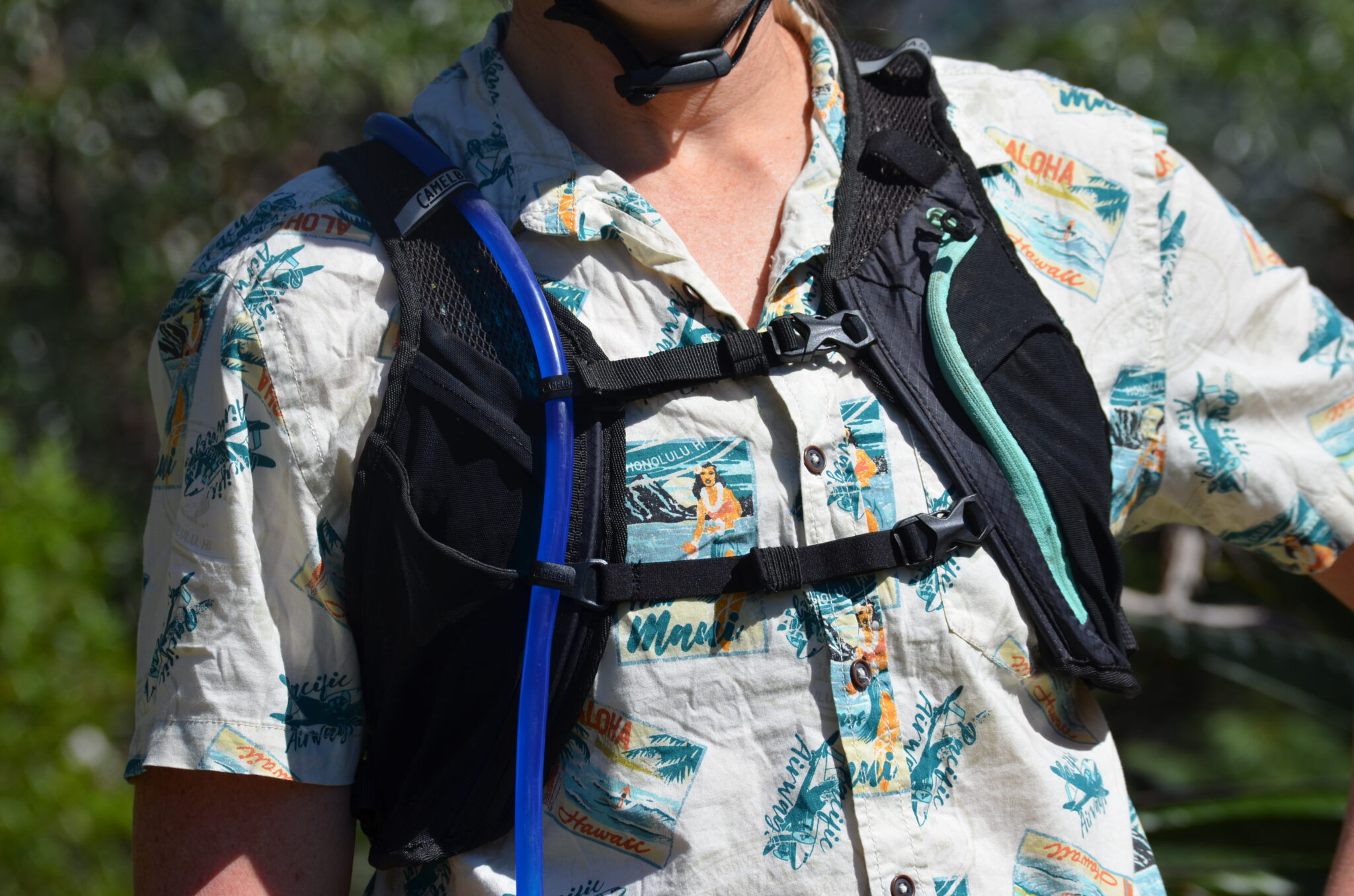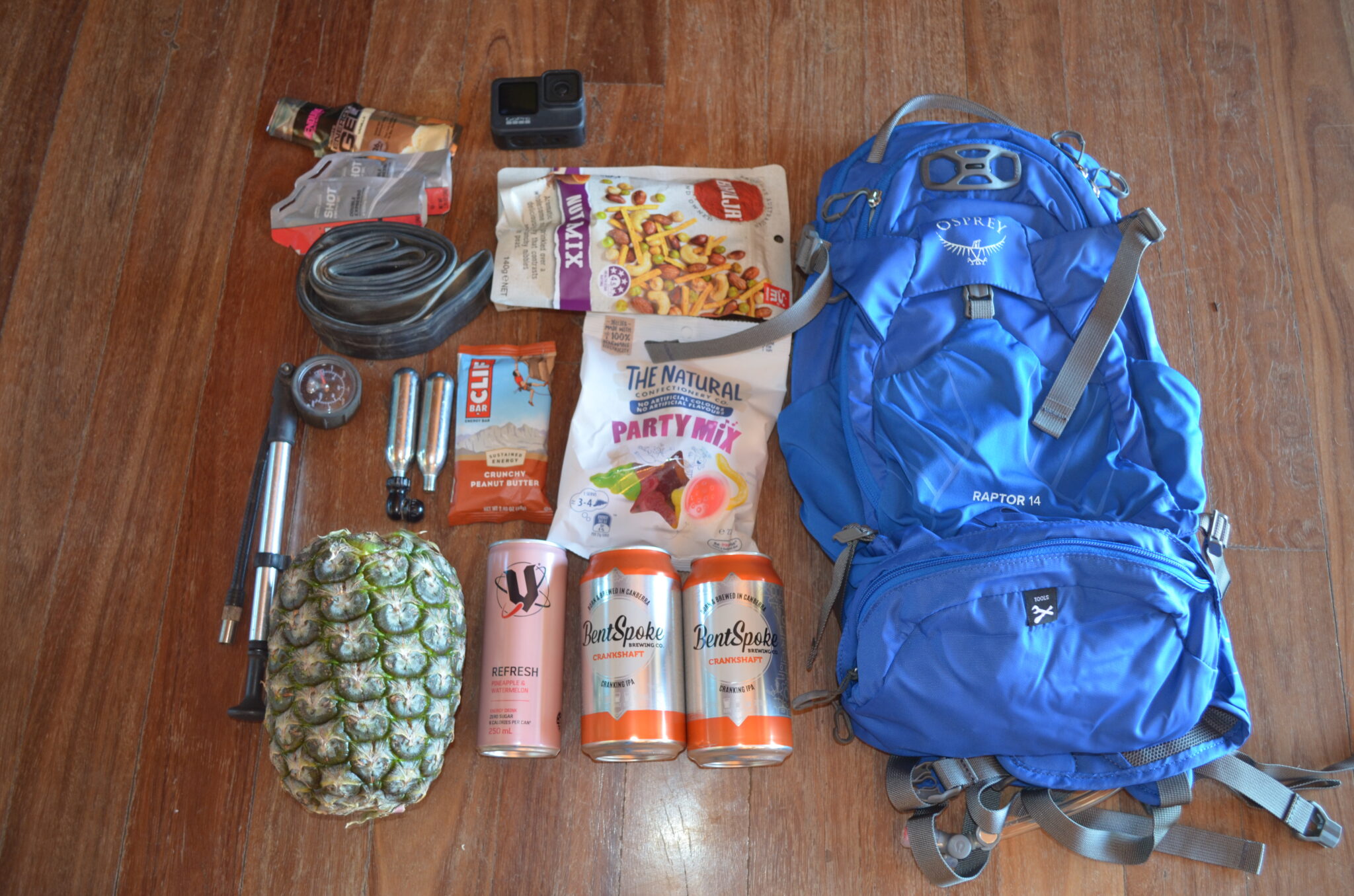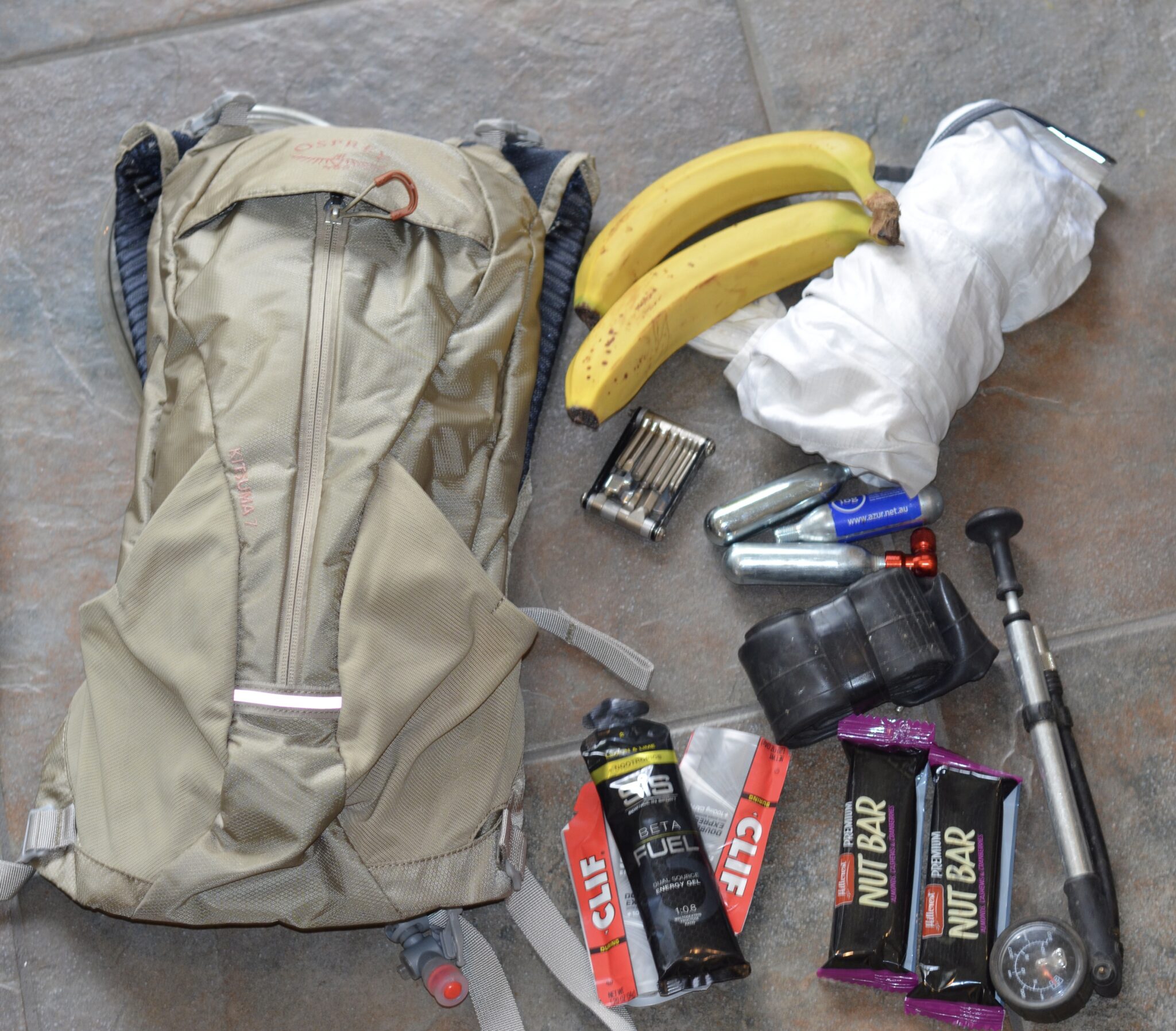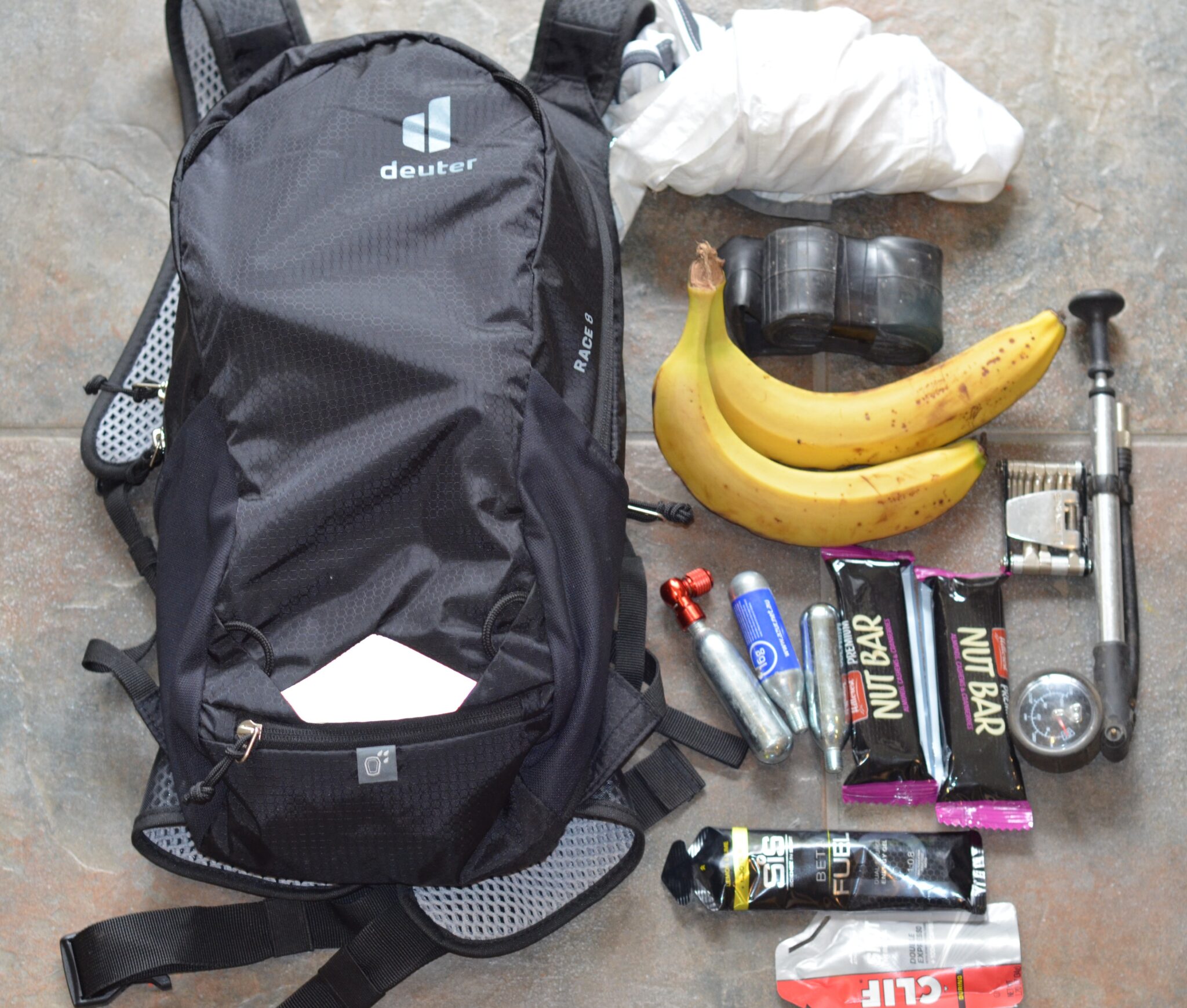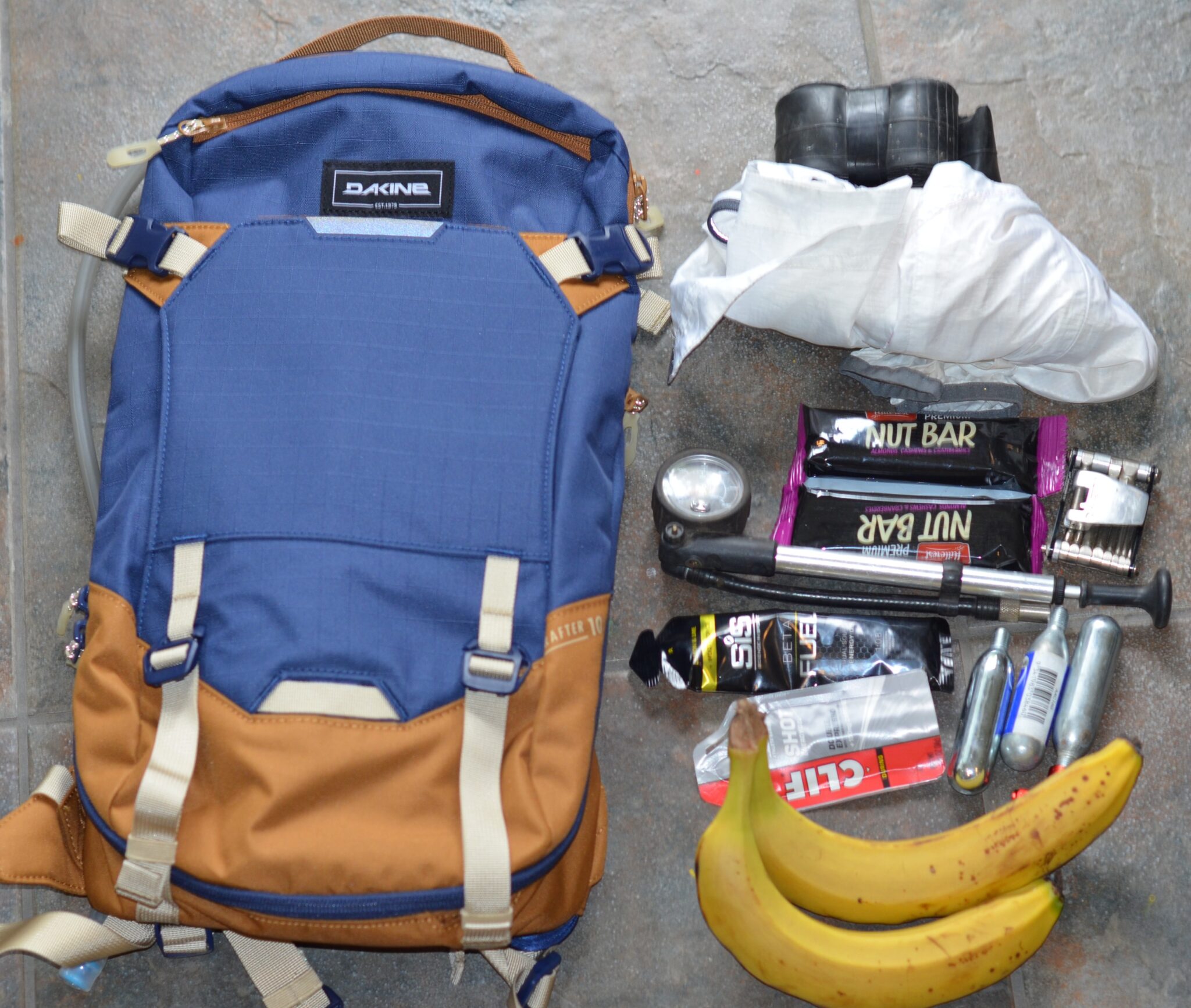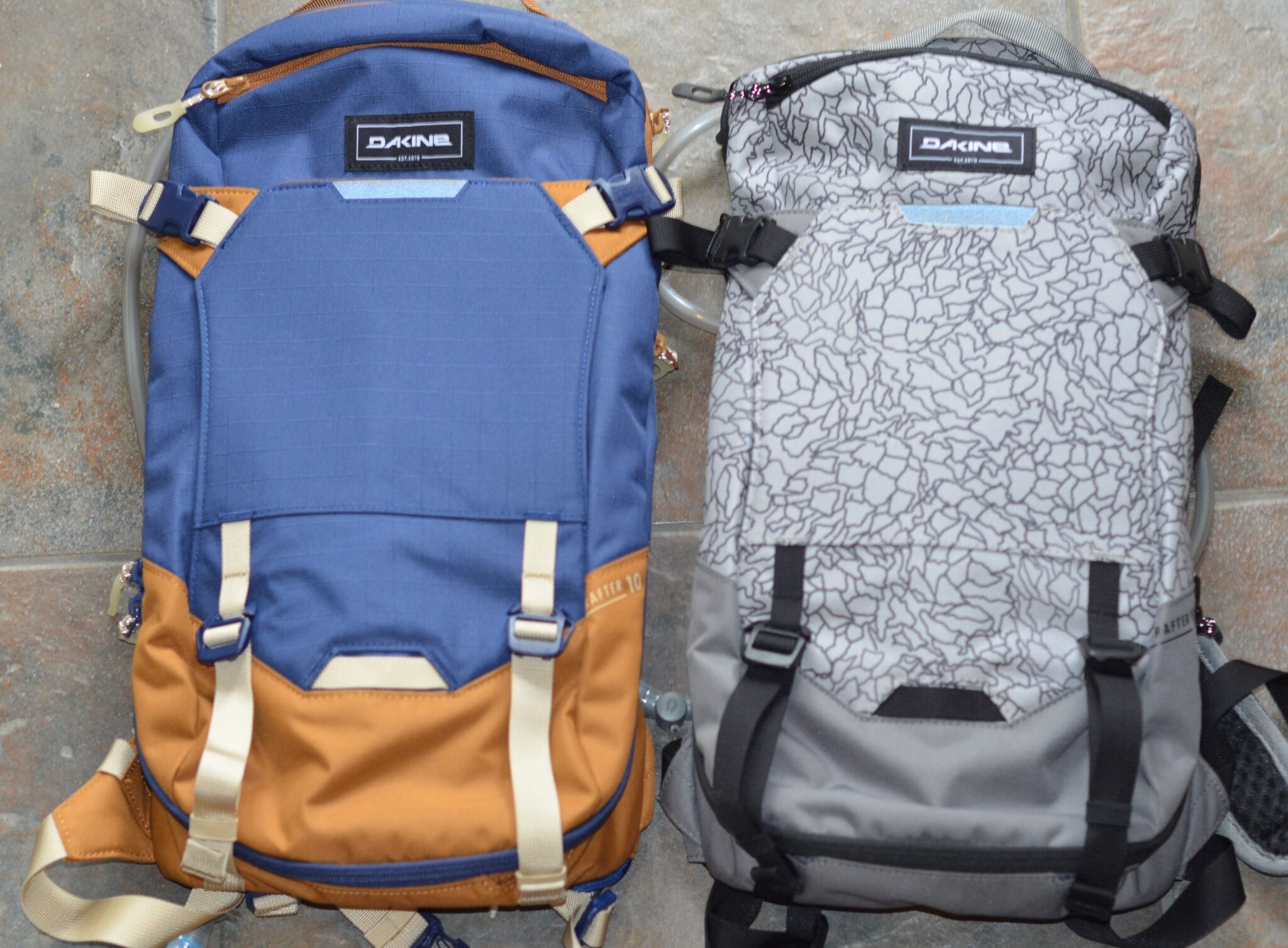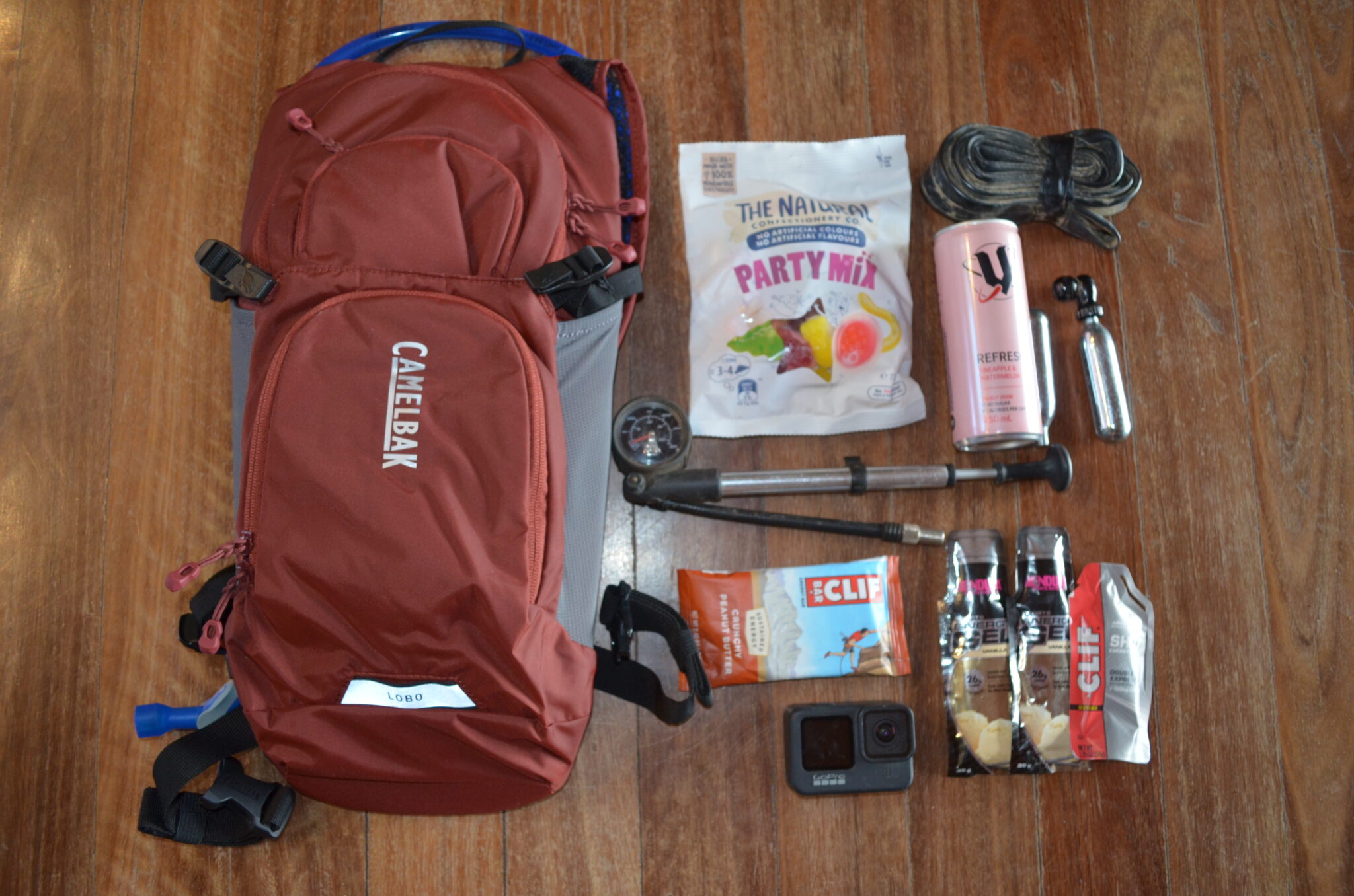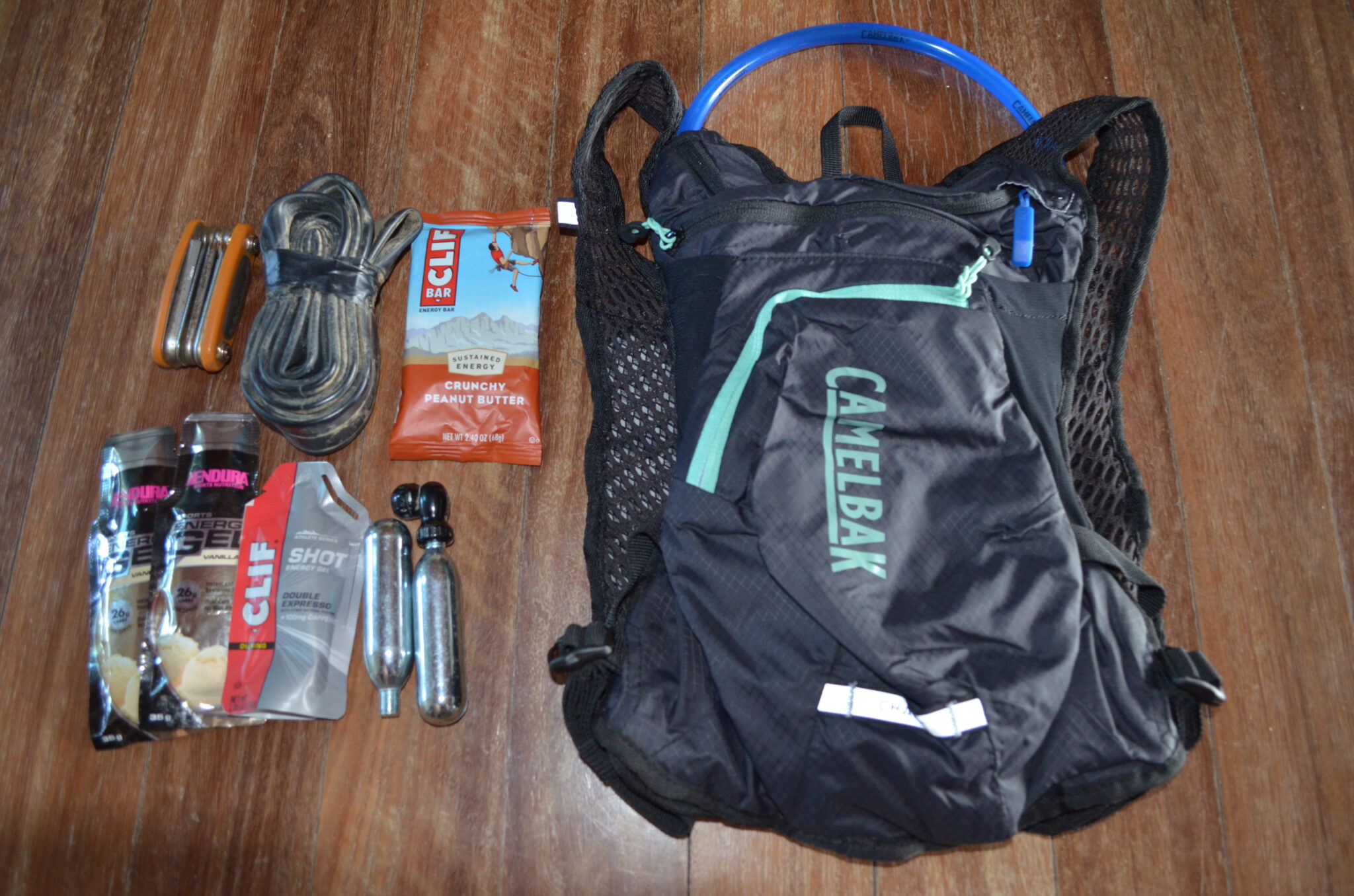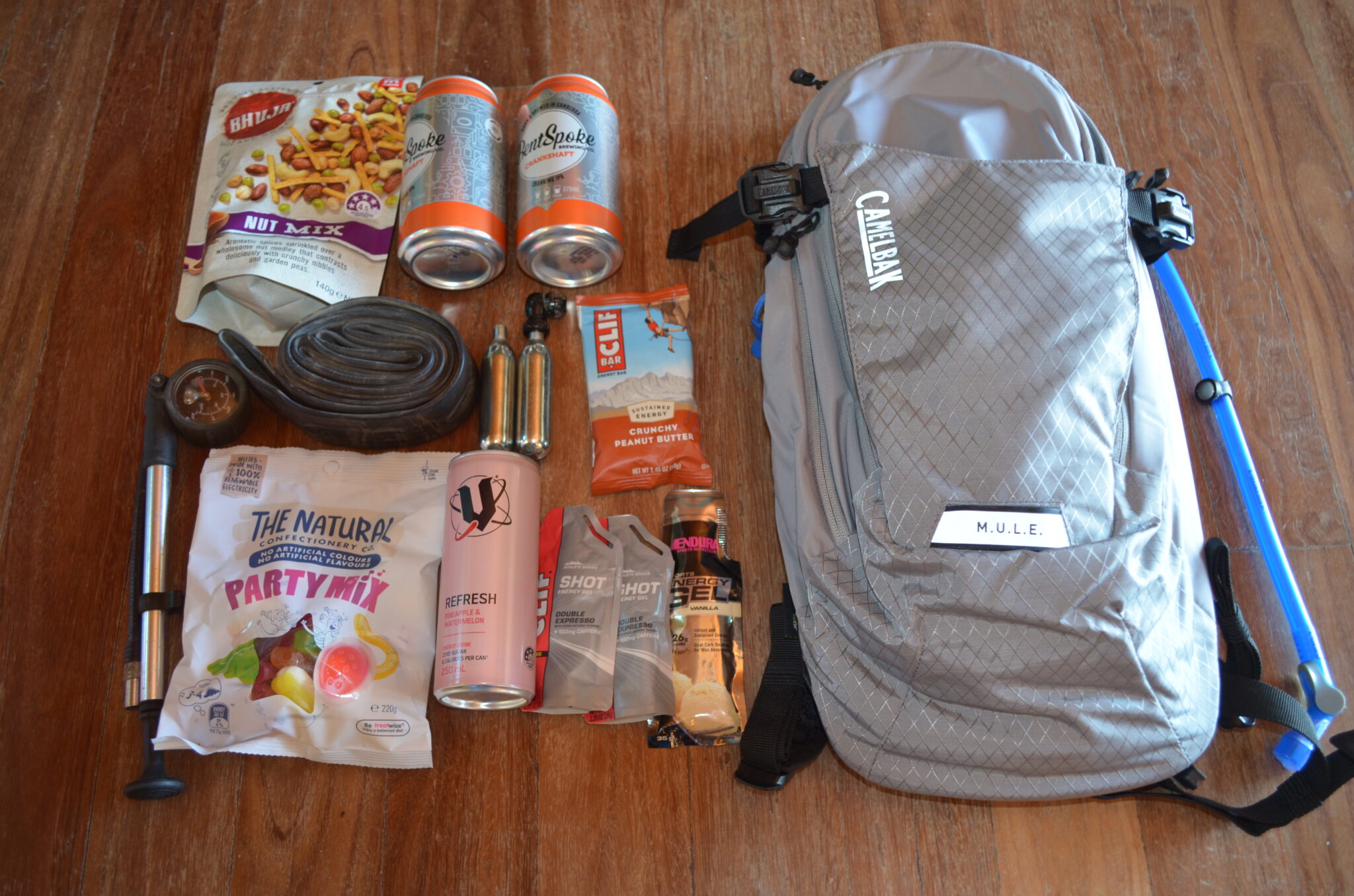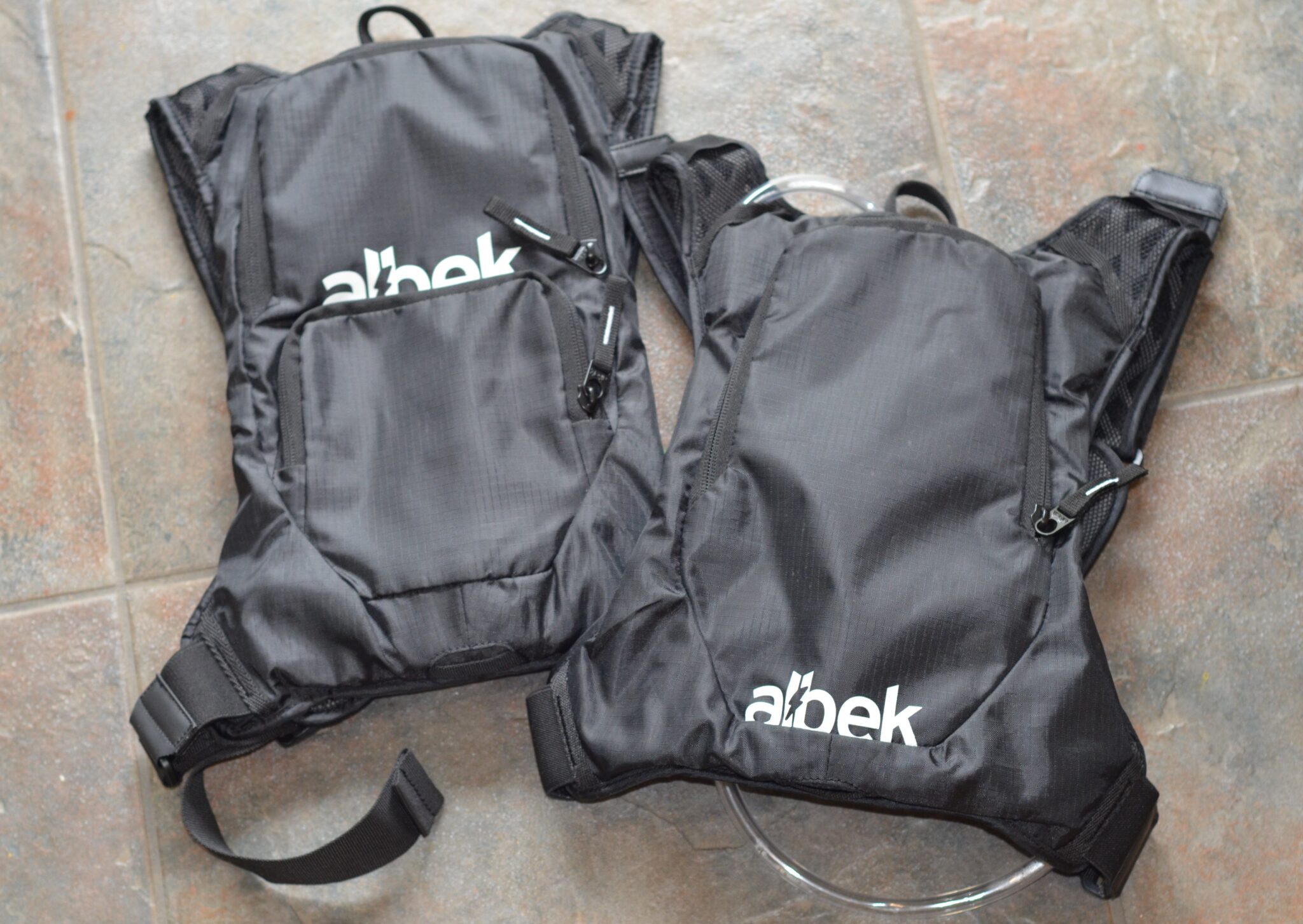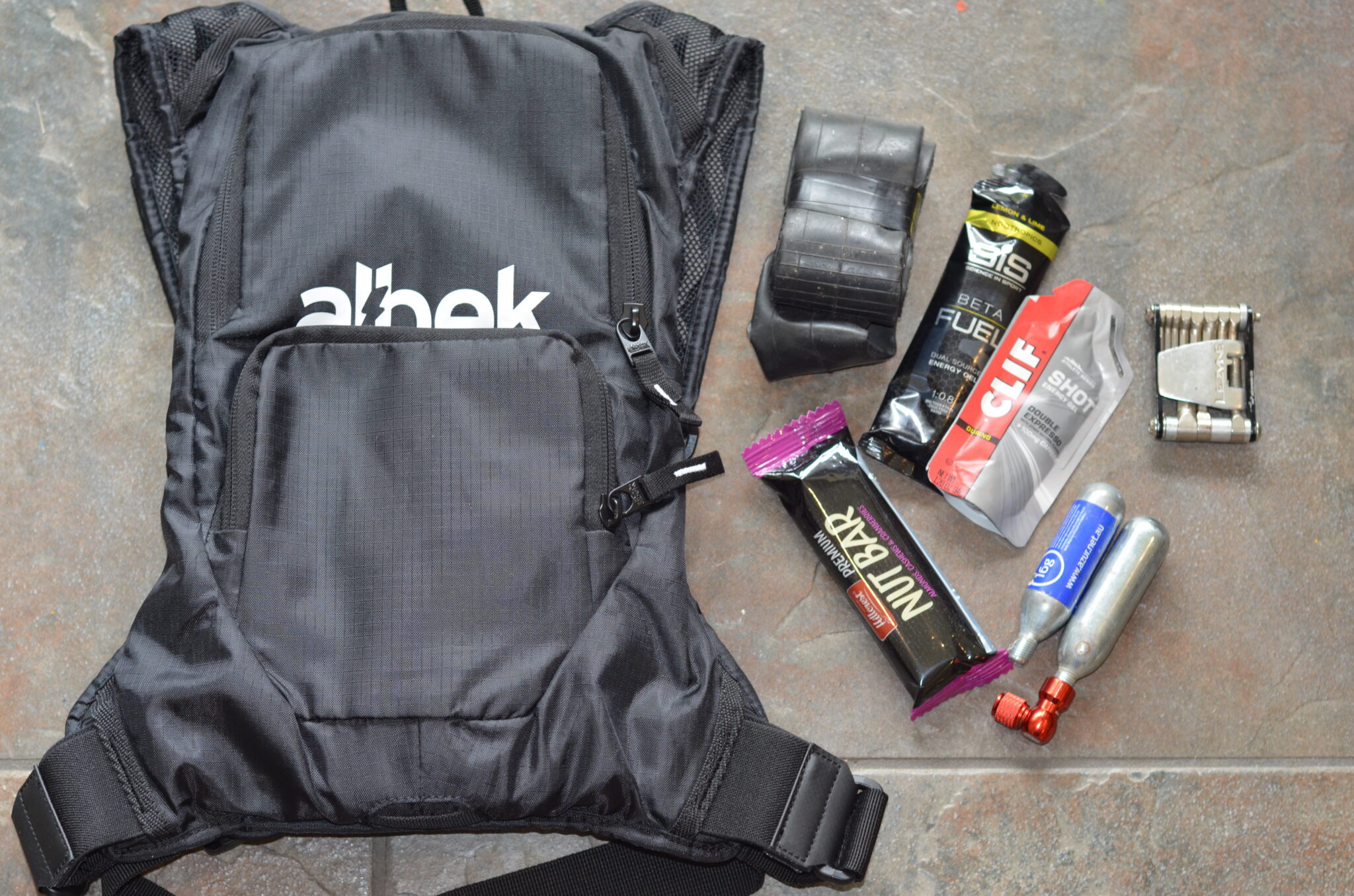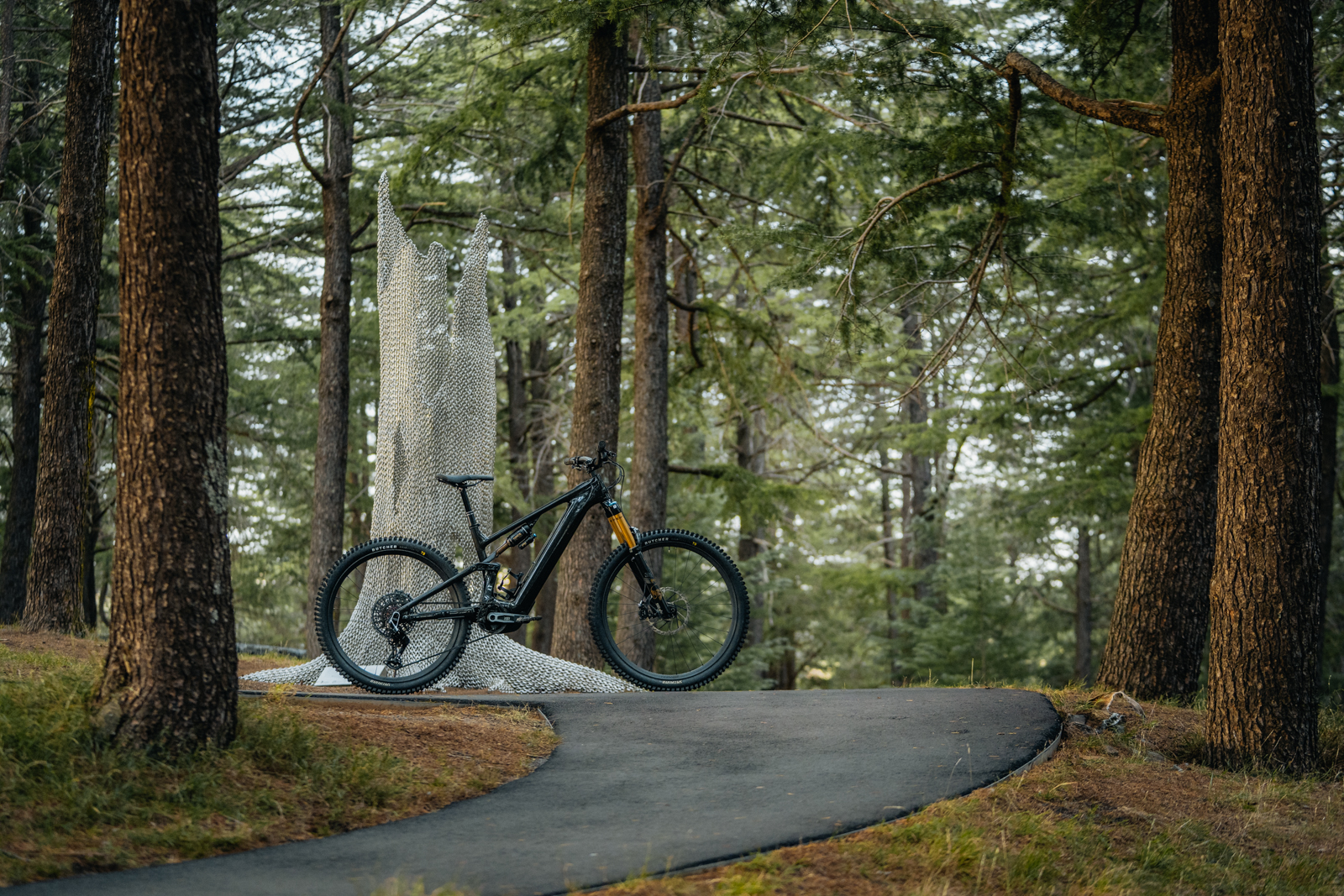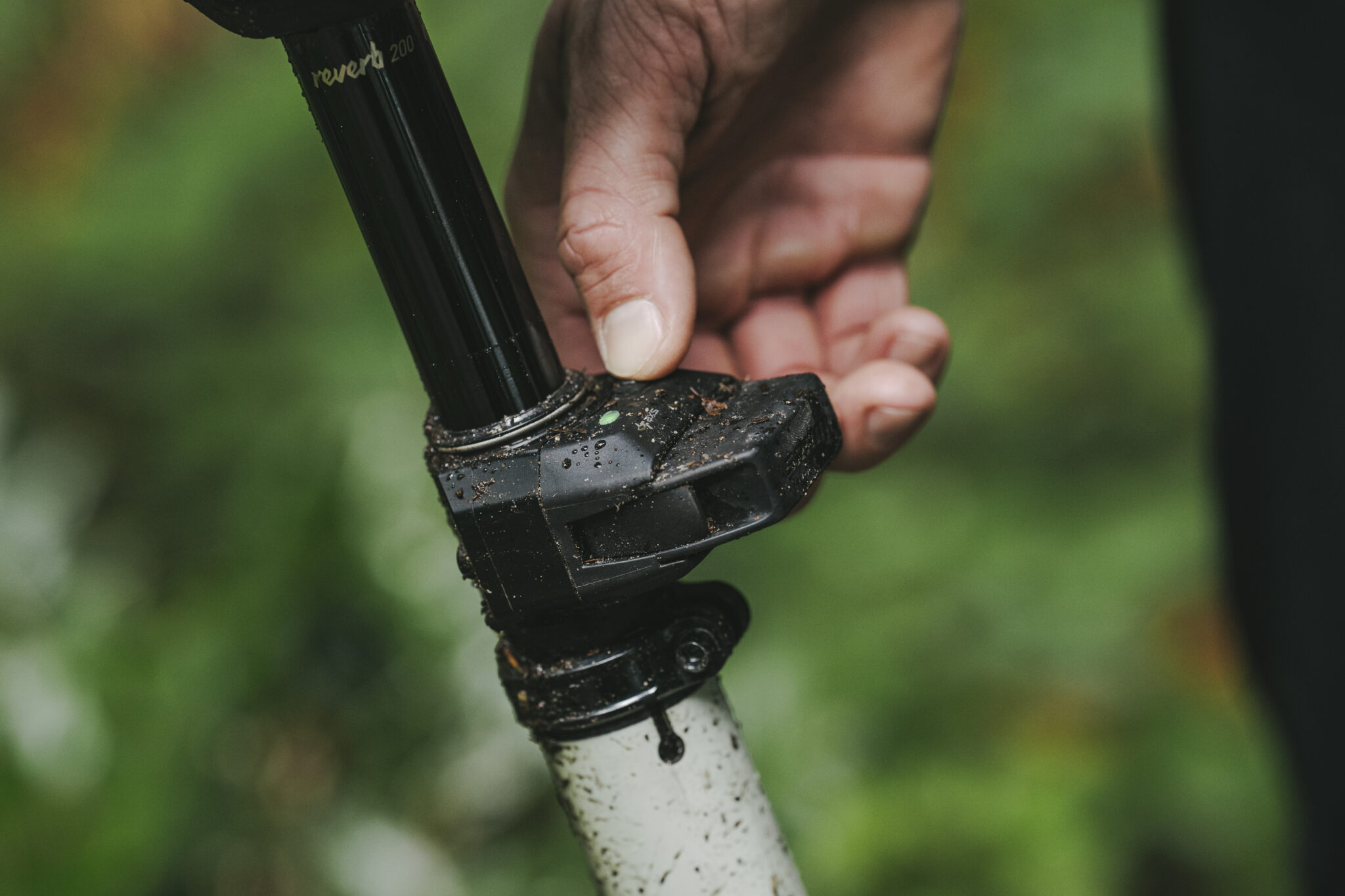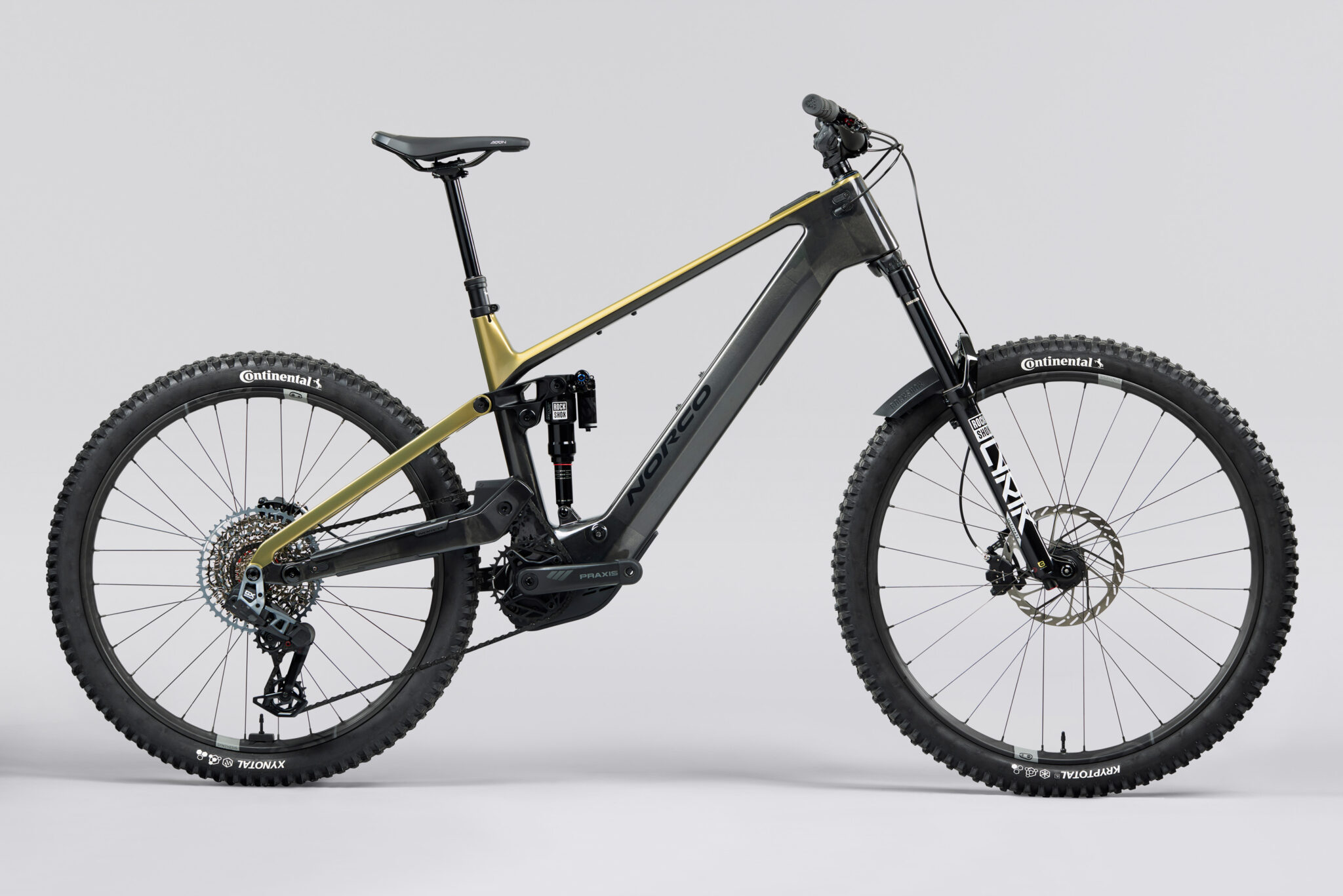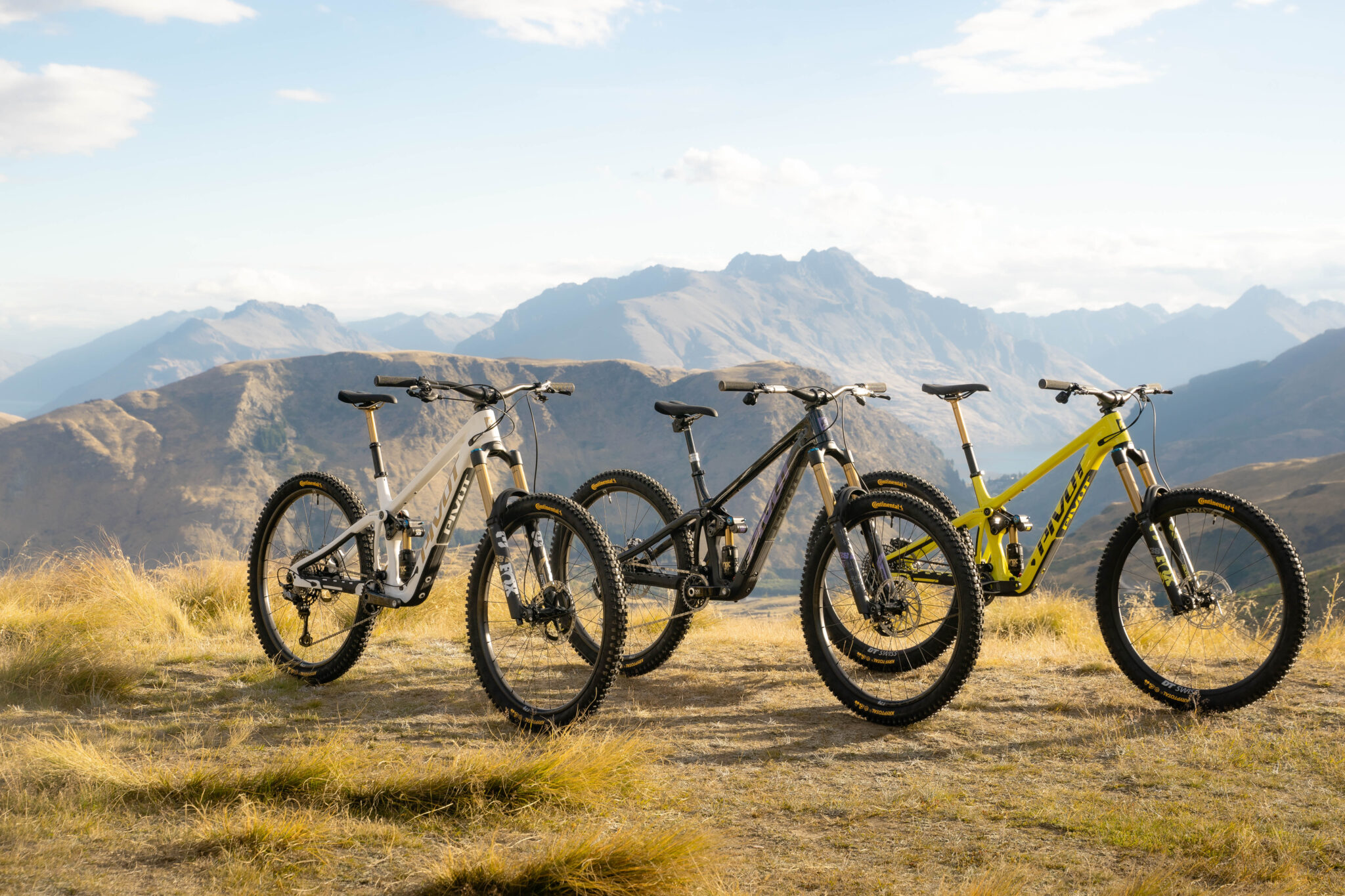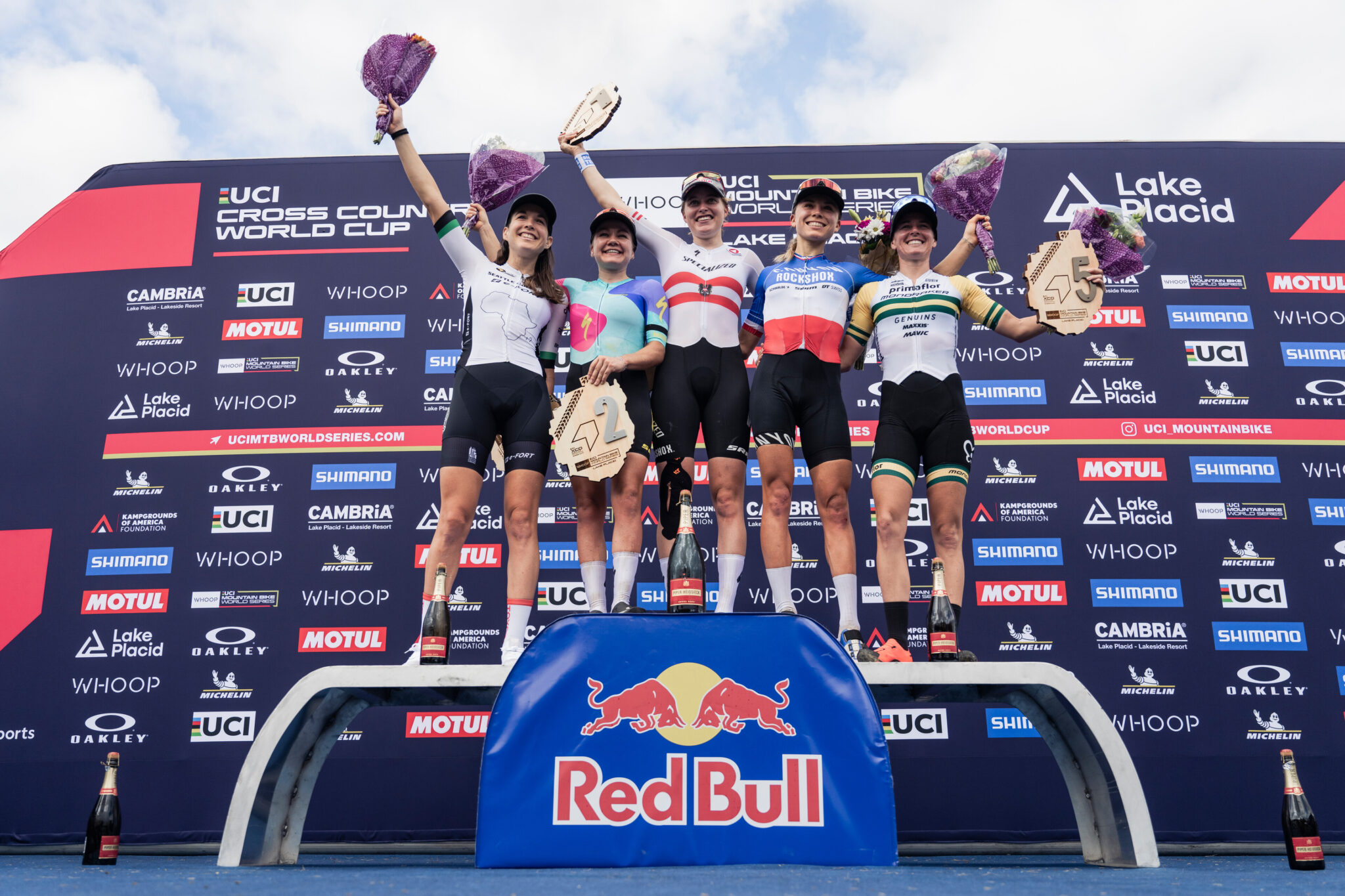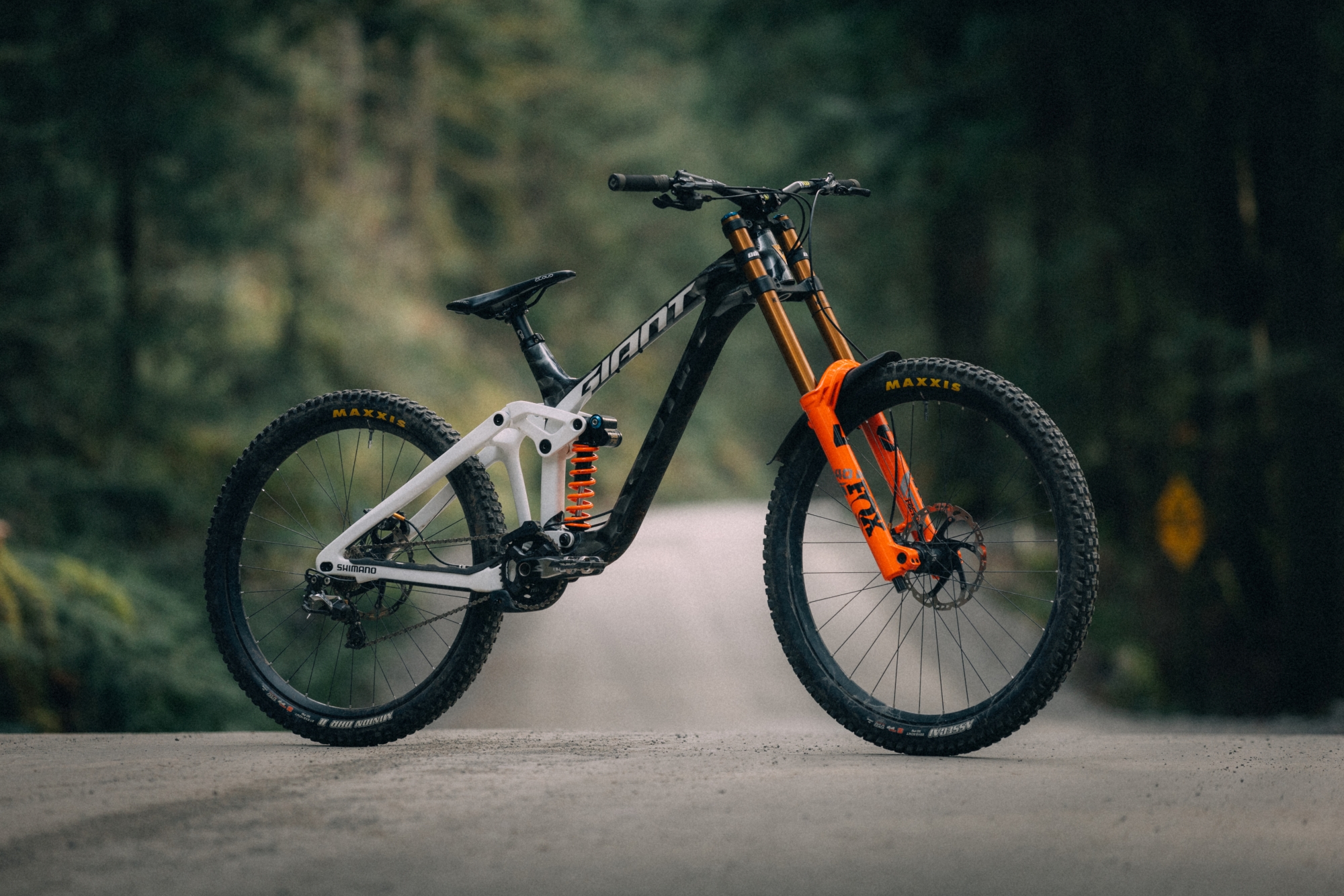Hydration Pack Group Test: The 12 Best Packs for Mountain Biking
Words: Anna Beck, Max Hobson
Photos: Elva Lefmann
If you’re off to your local bike park for a short jaunt before work, you can probably get away with a single bottle on your bike. But for those of us who enjoy longer rides, or to head out to the backcountry a single bottle just won’t cut it, enter the hydration pack!
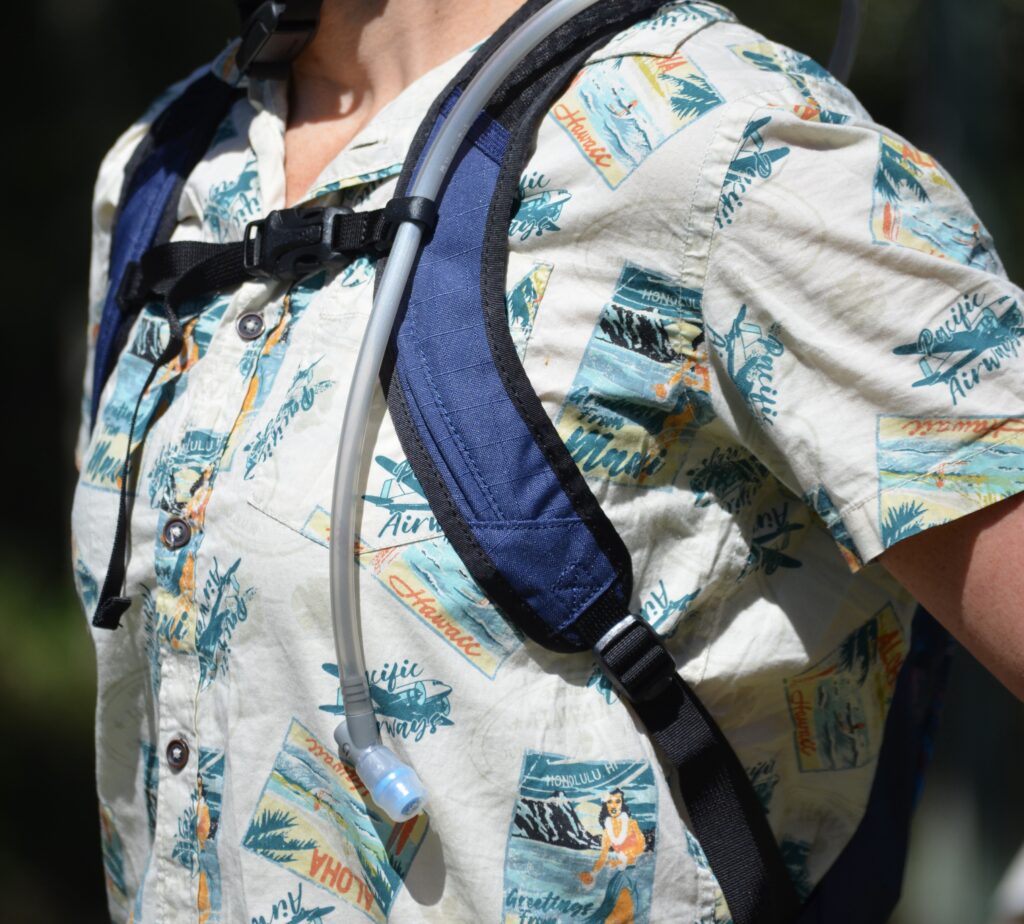
While there are both bum-bags (fanny packs?) and backpack-style hydration packs, in this group test we have chosen a range of trail packs focussed on carrying a little more than the bare essentials, without needing to pack the kitchen sink. We are predominantly looking at packs that will suit a big day of adventure without the need to pack clothes or essentials for a bike-packing trip.
Each of the options offer different ways of carrying your essentials, from the reliance on chest pockets for race-optimisation of the Camelbak Chase vest to the roomy deep Osprey raptor. Editorial team Max and Anna have been commuting, shredding and even trail running these packs to put them through their paces.
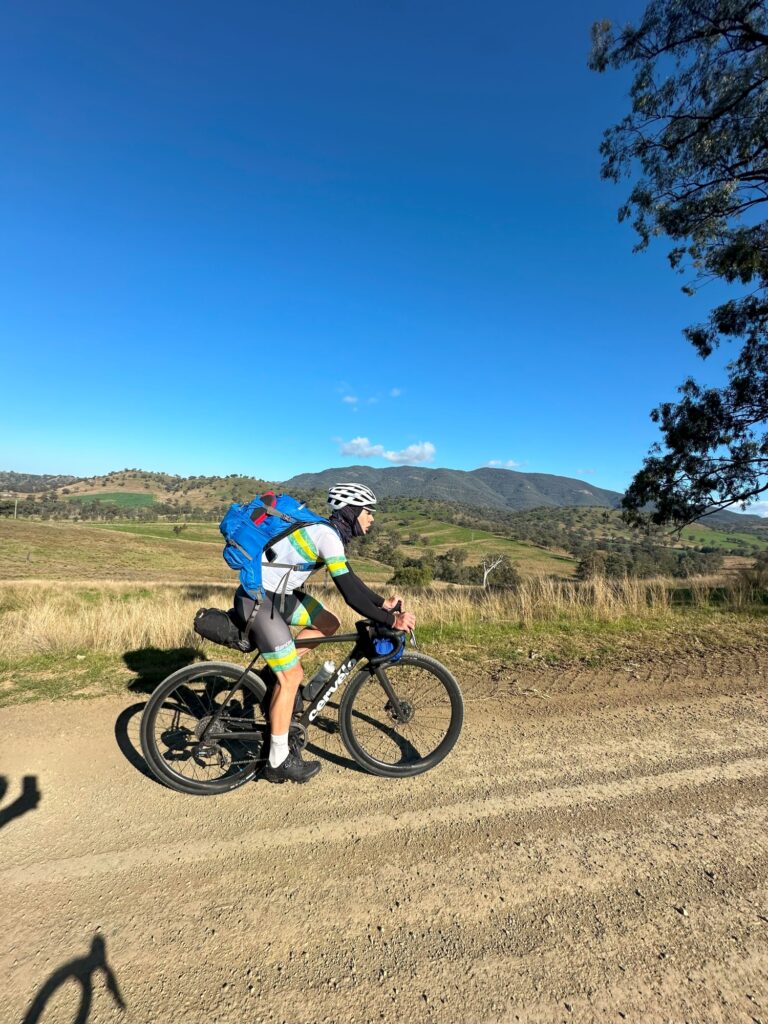
Being in Australia, hydration is integral when mountain biking due to our warm climate (except for you, Tasmania!), but many hydration packs can feel warm and paradoxically increase our body temperature if the fit is directly against the back or the material used is less than optimal. Within this review, we provide an overview of the pack and it’s key features and how it performs on the trail, and we then attribute ratings out of five on comfort, aesthetics and features and give it an overall rating.
Related:
– Trail and Enduro Mountain Bike Tyre Test
– Top 7 Trail Bikes Under $4600
– Best Hardtail Mountain Bikes Under $2000
– Best Mountain Bike Goggles
– Top 10 Best Tubeless Tyre Inserts
Notably, in this review we have separated hydration capacity and pack capacity, for example the Camelbak LOBO has an overall capacity of 9L, consisting of 7L of storage and 2L hydration. For the group test, this will be denoted by storage volume: 7L, hydration capacity: 2L. This means that swapping out the for a higher capacity bladder will inversely impact the storage volume.
For pack weights, we used the same scale for each one, and weighed including the bladder. This is because many packs will advertise the pack only weight, however each pack on test (bar one) came with a hydration pack, which is an integral part of the unit weight. Each pack was worn multiple times for a minimum of 5hrs use time in order to best assess function and fit.
Deconstructing a hydration pack:
Mesh: Key to effective heat transfer is either keeping the pack off the back or at least using a lightweight mesh along the contact. Almost all packs attempted to do this with varying degrees of success. We had some patented technology such as the Camelbak Air Support and Deuter Airstripes, which sought to suspend the bulk of the pack away from the body using lengthwise contact points allowing airflow between.
Mesh was also used in other key areas, including shoulder and waist straps.
Straps: There were a wide range of strap systems used, from the single chest cinch of the Camelbak Classic and central harness of the Albek range, to the comprehensive and supportive full waist and chest straps of the Deuter Superbike 8 and Osprey Raptor 14. We found having both the chest and waist straps preferable, and wider waist straps correlated to a more comfortable and secure fit.
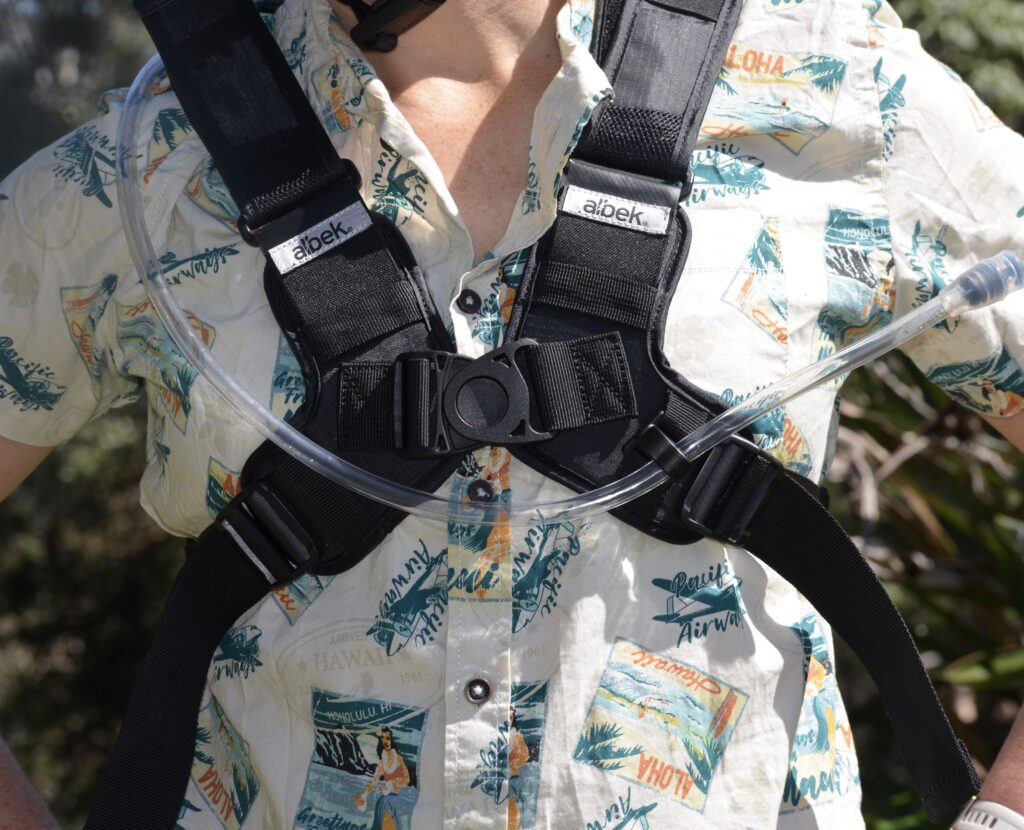
Storage and access: Each pack featured slightly different storage and access, with the bigger packs often requiring the rider to take off the pack and dive into the storage, while some of the more lightweight and mid-sized pack featured accessible mesh pockets on the body of the pack, or snack options on the shoulder straps (located on the chest). The configuration of each pack also varied slightly in terms of the interior: most packs featured a few internal pockets for valuables, and a few also featured helmet carrying features, for those who like to shuttle!
Fit: Fit is obviously quite a personal part of buying a pack, so what we looked for was the ability to adjust sizing and key features that made the packs more comfortable – such as fabric choice on shoulder straps, how the packs held their weight on the bike, and overall movement when loaded up.
Aesthetics: Obviously a personal thing, and secondary to function, but a metric nonetheless.
Durability: While we tested these packs for a few good solid rides each and won’t have a full long term test on them, we had a good look at what we felt were more and less durable features.
Hydration pack testers:
We have editor Anna Beck and digital manager Max Hobson on the test with the packs.
Anna Beck
Anna is a long-term junkie of endurance and trail riding. She tested the packs in a variety of activities, including on the trails, gravel riding, commuting via bike, hiking for coffee outside, and even trail running.
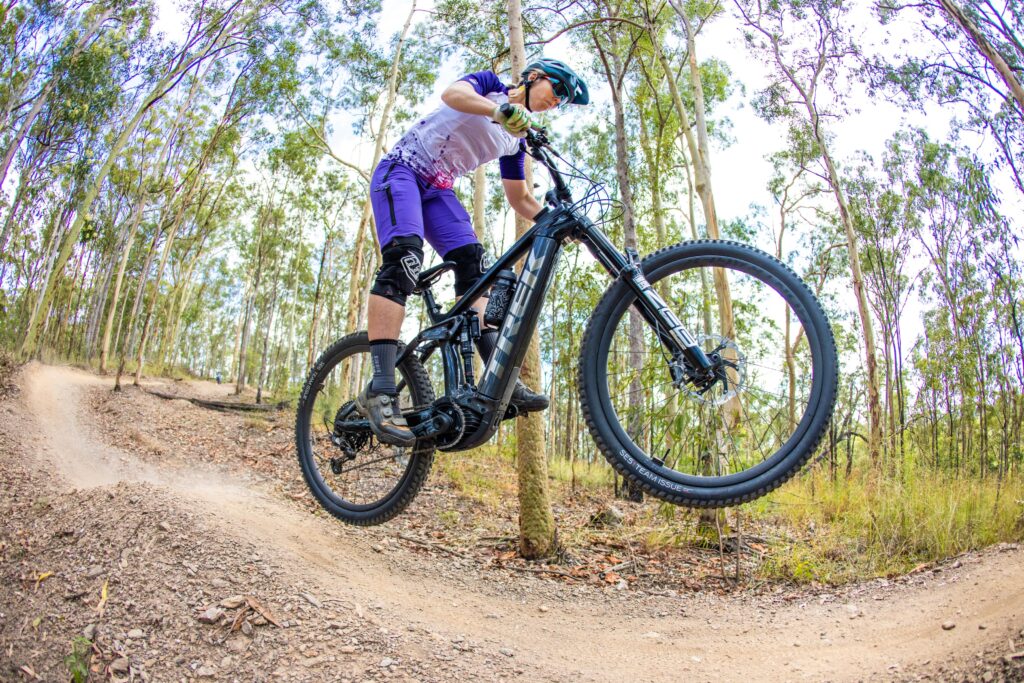
Height: 168cm
Weight: 64kg of postpartum glory.
Build: Deadlift compatible (broad shoulders, medium hips, large chest from feeding baby)
Favourite Snack to stash: Small can of coke, Natural Confectionary Co Fruit Jellies, corn chips
Max Hobson
Max leans more towards super endurance and skinnier-tired pursuits like bike packing and gravel cycling, comprehensively testing his share of packs on endurance training rides and multi day bike packing trips.
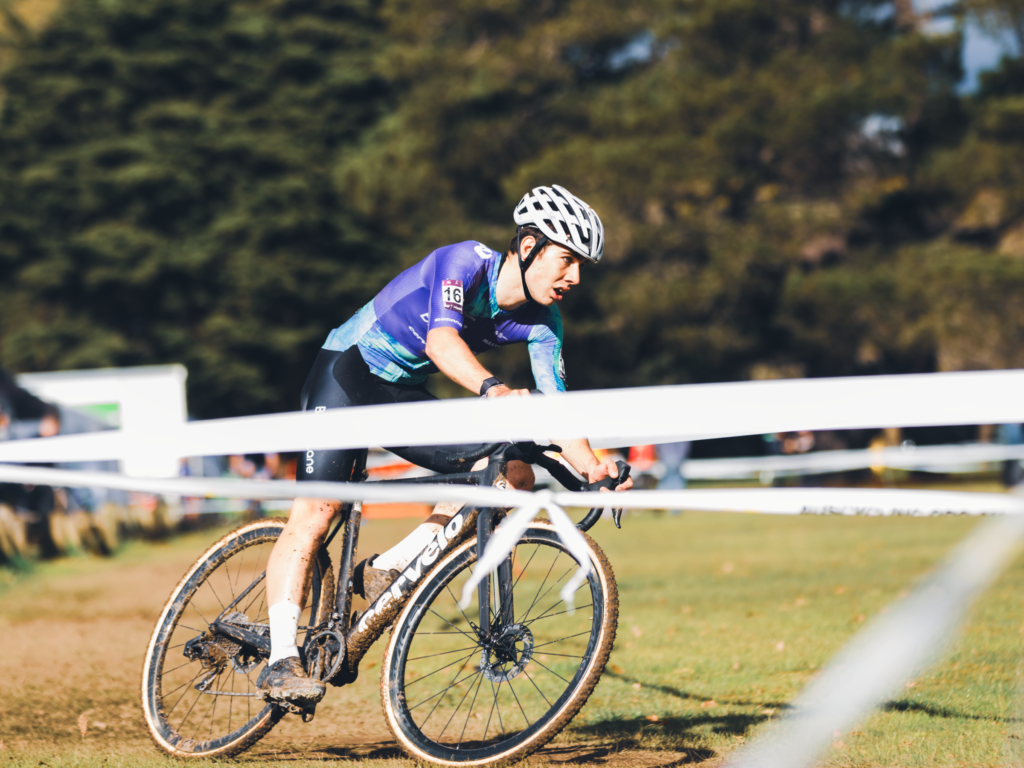
Height: 178cm
Weight: 64kg
Build: Narrow noodle/‘doing the road miles’
Favourite Snack to stash in the pack: High carb beer
Hydration Packs for Mountain Biking
- Albek Haul 3
- Albek Haul 4
- Camelbak Chase Vest Mens
- Camelbak Chase Vest Women’s
- Camelbak Hydrobak
- Camelbak LOBO
- Camelbak MULE
- Dakine Shuttle 6
- Dakine Drafter 10L
- Deuter Race 8
- Osprey Kitsuma 7
- Osprey Raptor 14
Albek H2O Haul 3 & Haul 4
RRP: Haul 3: $129.95 | Haul 4: $149.95
Weight: Haul 3: 429g | Haul 4: 505g
Storage volume: Haul 3: 1.5L | Haul 4: 2L
Hydration Capacity: Haul 3: 1.5L | Haul 4: 2L
The Albek brand of packs is new to the scene, and their range of hydration packs and bags caters specifically for the mountain bike and motorcycle market. They can be seen across the speedy shoulders of riders like Brendan Johnson who is in need of some extra hydration while racing in the Lifetime Grand Prix series of predominantly long and gruelling gravel races.
With an ‘X brace’ harness system, the two Albek Haul packs on these (3 and 4 models) both feature a shorter body, and central locking harness in lieu of a chest and waist strap. The buckle for securing the pack is able to swivel, meaning it’s easy to get the pack on and secured if you’re in a hurry (or in a feed zone). The Haul range features four points of adjustability for the pack: the lower straps with bucket and regular backpack adjustment fabric that intersects with the L-shaped section that secures the swivel, while the upper strap adjustability is facilitated through broad mesh shoulder straps, that are secured with velcro and are easy to adjust on the go.

Like many of the packs on test, Albek has specifically used mesh for shoulder harness straps and has also incorporated cooling features like raised foam blocks with a mesh overlay on the back to keep your temperature in check on warm days.
The Albek pack came fitted with a 1.5L (Haul 3) or 2L (Haul 4) Albek branded bladder, which operated similarly to the Osprey bladder with a sliding mechanism that secures your fluid once filled and folded. The hose system is easily detached for cleaning (and mould avoidance!), though removing the drinking valve proved a little tricky.
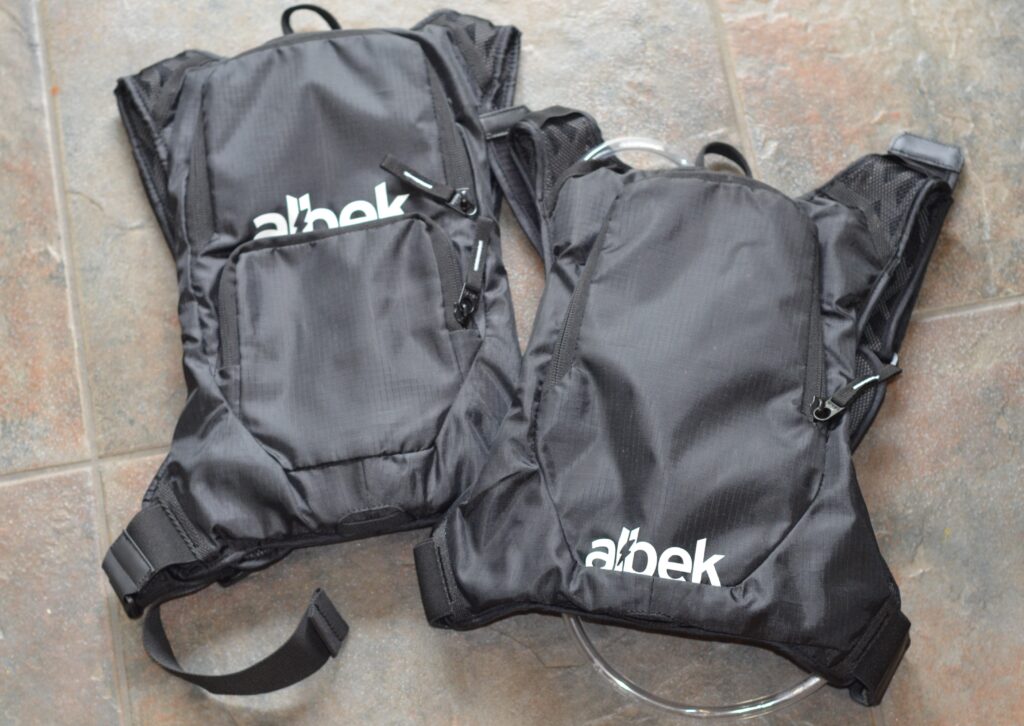
Taking the Haul 3 for a spin was a no-brainer for a longer endurance ride that featured some lycra: it has scant storage with only one internal, small pocket. Despite this, it’s a lycra lover’s dream, as the higher positioning renders your spandex jersey pockets useful. This makes it a great pack for a racing whippet who is picking up feeds on the go, the ease of securing the pack with the central locking harness could save many a rider who has found themself tangled with straps while taking a hydration pack ‘handup’ in a feed zone.
READ: Don’t go bike packing without these essentials
For those who are less lycra-adjacent or who lack pockets in their daily riding attire, the Haul 4 features 2L storage volume: not a premium amount but enough for some snacks and spare tube or canister in the added zippered section on the front of the pack. As such, we ended up preferring the Haul 4 for its versatility, though it must be noted it did lack some accessible side or chest pockets that we relied upon with some of the other packs we tested. Is this an issue? Not necessarily, if you’re planning to stop and grab some food at a trailhead or if you have your spare snacks stashed elsewhere and you’re looking at a pack purely for hydration.
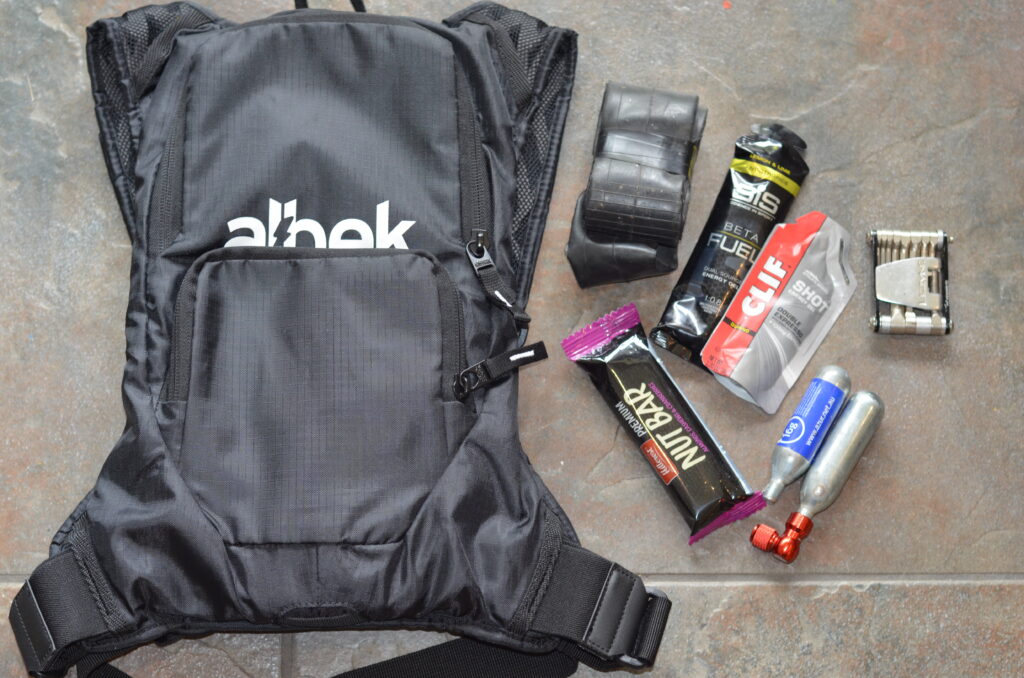
We found the pack extremely comfortable and easy to adjust on the fly, and found ourselves using this feature as we headed to more technical trails in order to reduce pack movement. We did find we had to wear the pack quite firmly in order to reduce pack jiggle, due to the single central buckle, but it remained one of the most comfortable packs on test despite this.
Who’s it for? The Albek Haul packs we covered were definitely a more minimalist offering than others on test, and would be prime for someone taking a quick pack hand in a feed zone with their spares and food secured elsewhere. The Haul 4 featured a little more space and could be a great option for a big day on the shuttles or where accessing food isn’t on the go. These packs are for anyone who disagrees with a standard chest and waist strap configuration.
More info here
Ratings
HAUL 3:
Comfort 5
Aesthetics 4
Durability 4
Features 2
Overall 3.5
HAUL 4:
Comfort 5
Aesthetics 4
Durability 4
Features 3
Overall 4
Camelbak Chase Vest Womens
RRP: $199.00
Weight: 465g
Storage volume: 2.5L
Hydration Capacity: 1.5L
The Camelbak Chase vest hydration pack is the OG of lightweight cycling hydration vests. While this concept has taken the running world by storm, we are only just seeing the bike hydration ‘vest’ take off in bike land. As a heavyweight in the hydration world, Camelbak has thought of almost everything with their chase vest.
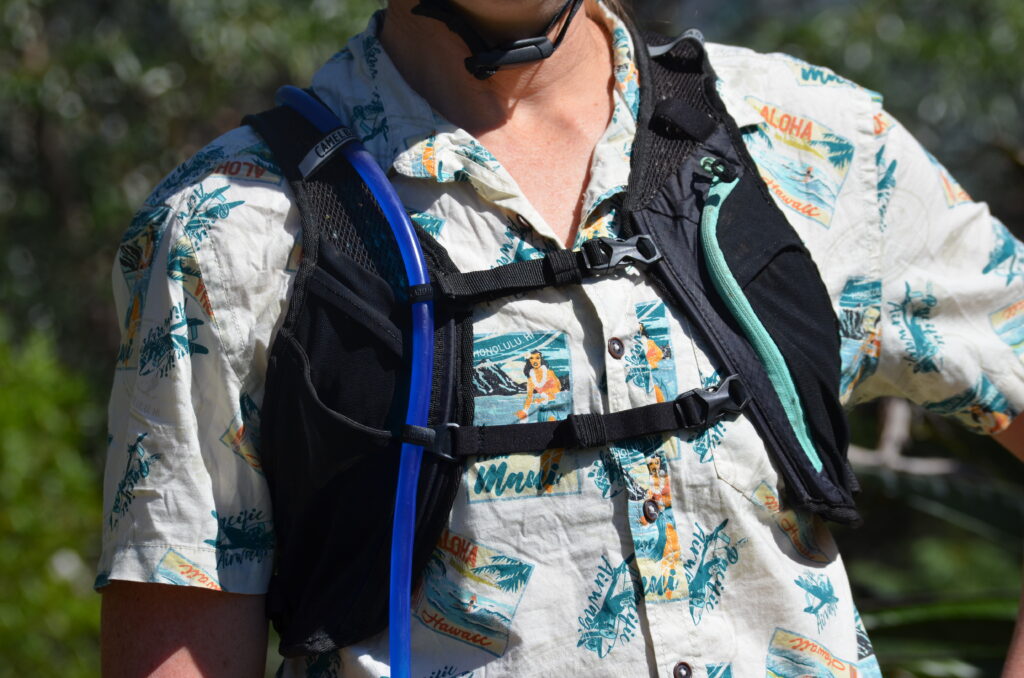
The Chase Vest is an ultra-lightweight, racy option with only 2.5L storage and 1.5L hydration capacity. As such, it’s a pack built for moving fast and not carrying a lot, but the capacity it does offer is highly functional: the bilateral chest pockets feature a sleeve and a zip pocket for ease of snack access, but just as easily can carry a small phone, while the main zip pocket requires pack removal for access, but easily fits a tube and canister or extra snacks…but not both.
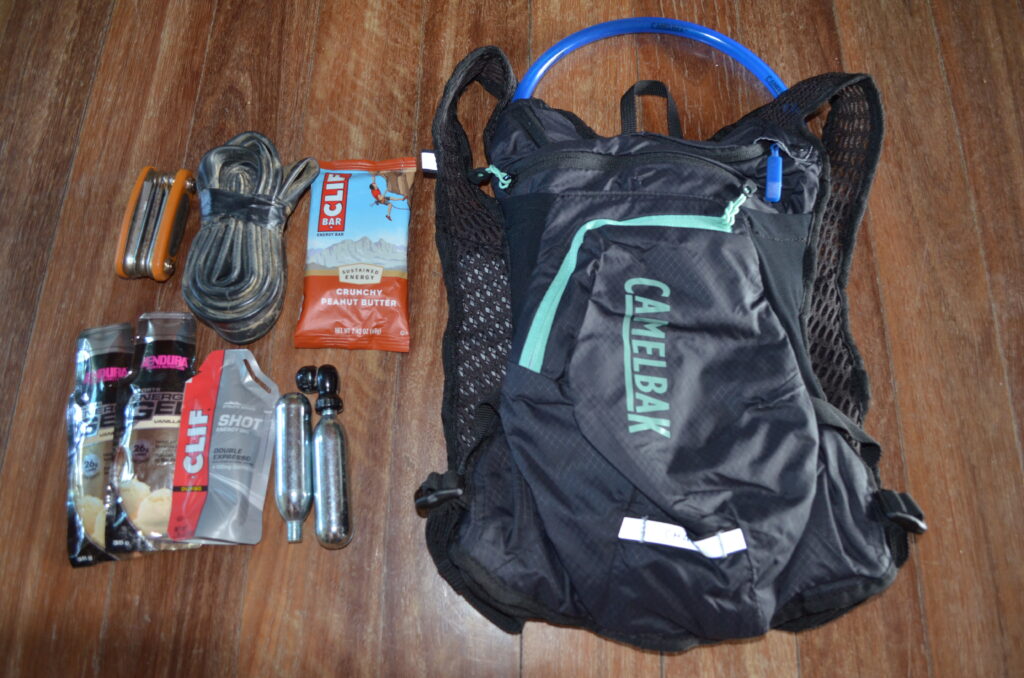
Instead of a waist strap, the Chase Vest features two chest straps, and as it’s designed to sit high on the torso these offer support and stability in lieu of an extra waist strap.
While it doesn’t feature a magnetised hose holder like some of the other Camelbak and Osprey offerings, the hose of the bladder is tucked away with two hooks on the right chest pocket, keeping it tidy and secure for technical trails or even the jostling of a run.
While the mesh back of this pack did sit directly on the back, the small real-estate from the pack size meant that it didn’t seem overly hot, and as a plus for those wearing lycra the fit gives the ability to access rear jersey pockets. The chest pockets were also meshed for good heat transfer.
More info here
Ratings:
Comfort 5
Aesthetics 4
Durability 3
Features 4
Overall 4
Who’s it for? The Camelbak Chase Vest is for the rider who’s going places: fast. With only 1.5L hydration and minimal storage, the Chase vest is about optimising your equipment for weight and speed.
Camelbak Chase Vest Mens
RRP: $199.00
Weight: 480g
Storage volume: 2.5L
Hydration Capacity: 1.5L
My time with the Camelbak Chase Vest hydration pack was quite extensive. After hearing about the upcoming Hydration Pack Group Test I was keen to take out the Camelbak Chase for some training runs before the 2024 Gravel Cycling National Championships in Derby Tasmania.
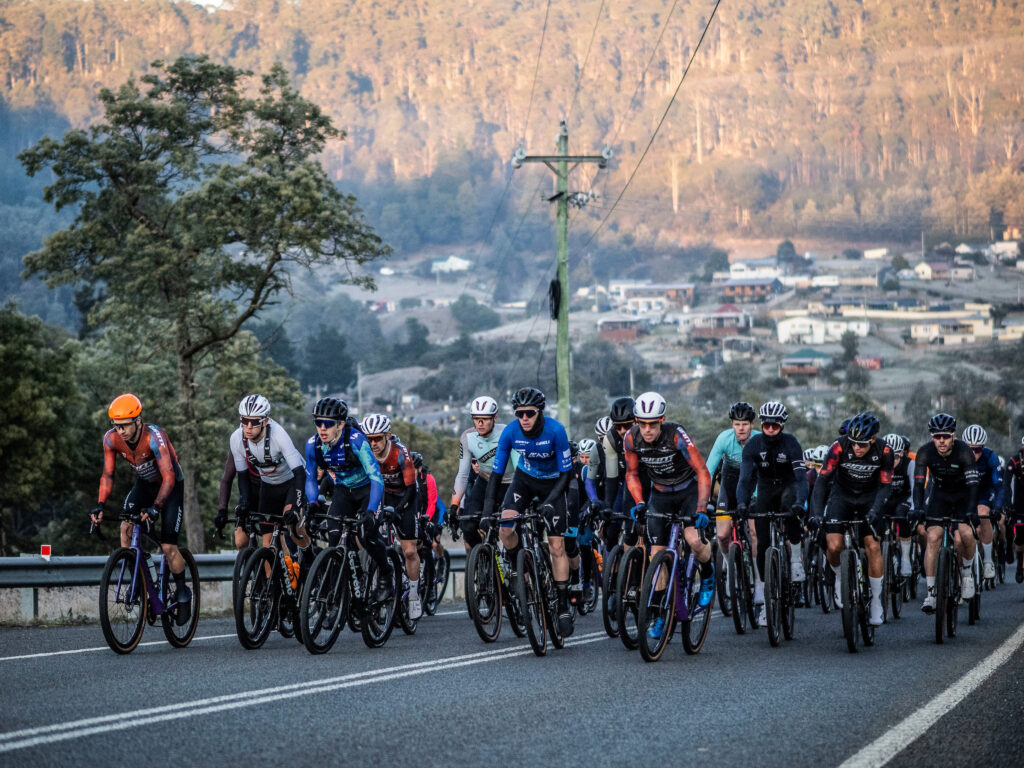
I found the Camelbak Chase Vest to be perfect for my training rides in the lead up, it was large enough to carry my essentials for 4-5 hour rides, but not too large that it became annoying.
The men’s chase vest is very similar to the women’s, it features two mesh chest pockets which I was able to squeeze six gels and two Cramp Fix’s into. The main compartment easily had enough space for me to fit all my race spares as well.
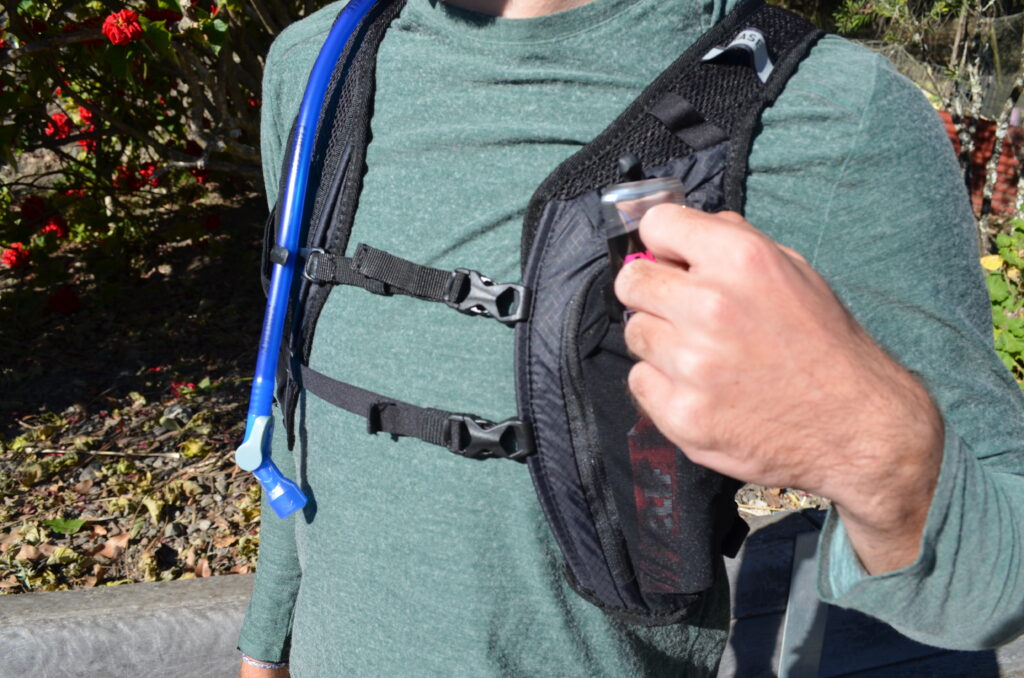
During the race, I honestly forgot it was even there. I was happy to have the pack with me as it made fuelling during the race much easier.
More info here
Ratings
Comfort 5
Aesthetics 4
Durability 4
Features 3
Overall 4
Who’s it for? In my opinion, the Camelbak Chase Vest is for someone who is travelling light. Perfect for gravel riders, marathon riders and ultra endurance riders.
Camelbak Hydrobak Light
RRP: $99.99
Weight: 170g
Storage volume: 2.5L
Hydration Capacity: 1.5L
The Camelbak Hydrobak Light hydration pack stands out in red. This pack is a staple in Camelbaks lineup designed to be a sleek and ultralight pack that is suitable for rides that don’t require you to take too much. The bag has around 1L of storage space including a 1.5L bladder. I’ve owned a few of these over the years so am no stranger to this pack.
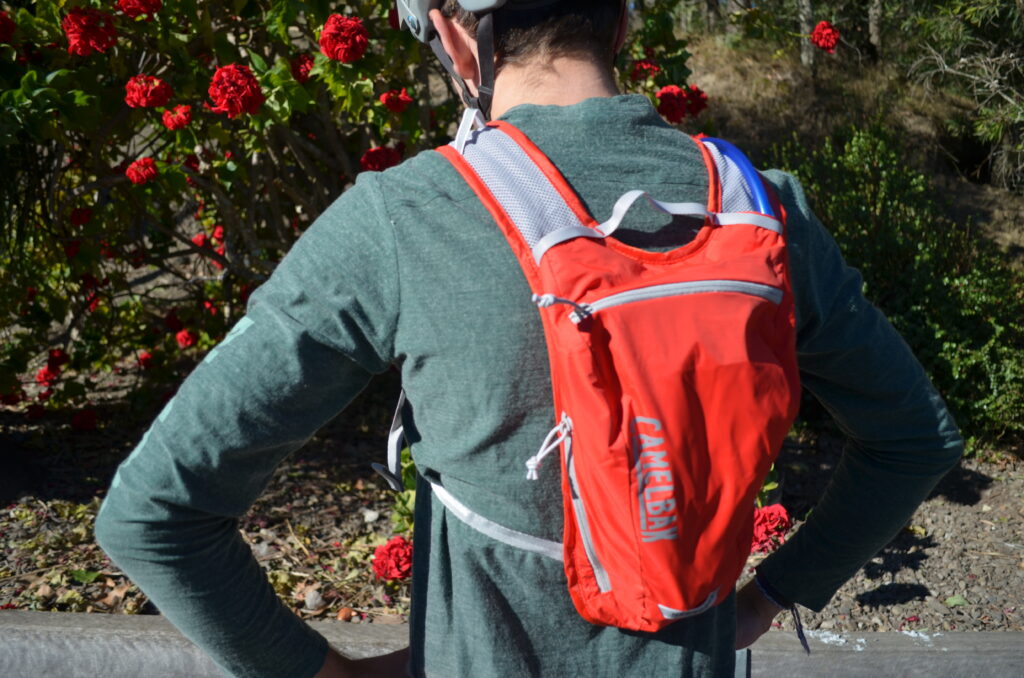
Now there’s not much to the Camelbak Hydrobak. This is why so many riders, including myself, love it. It’s simple by design and doesn’t allow you to take more than you’d need for shorter rides. If you’re looking for a pack to carry food, spares, water and more, you will have to look past the classic.
The Hydrobak isn’t super snug due to its simple design, but that’s not to say it’s uncomfortable. It’s super lightweight and you can barely feel it on your back. For road and fire road riding you pretty much forget it’s there, however once you start hitting gnarly terrain you can notice it moving around on occasion. This movement is mostly because the bag only features a sternum strap with no hip belt.
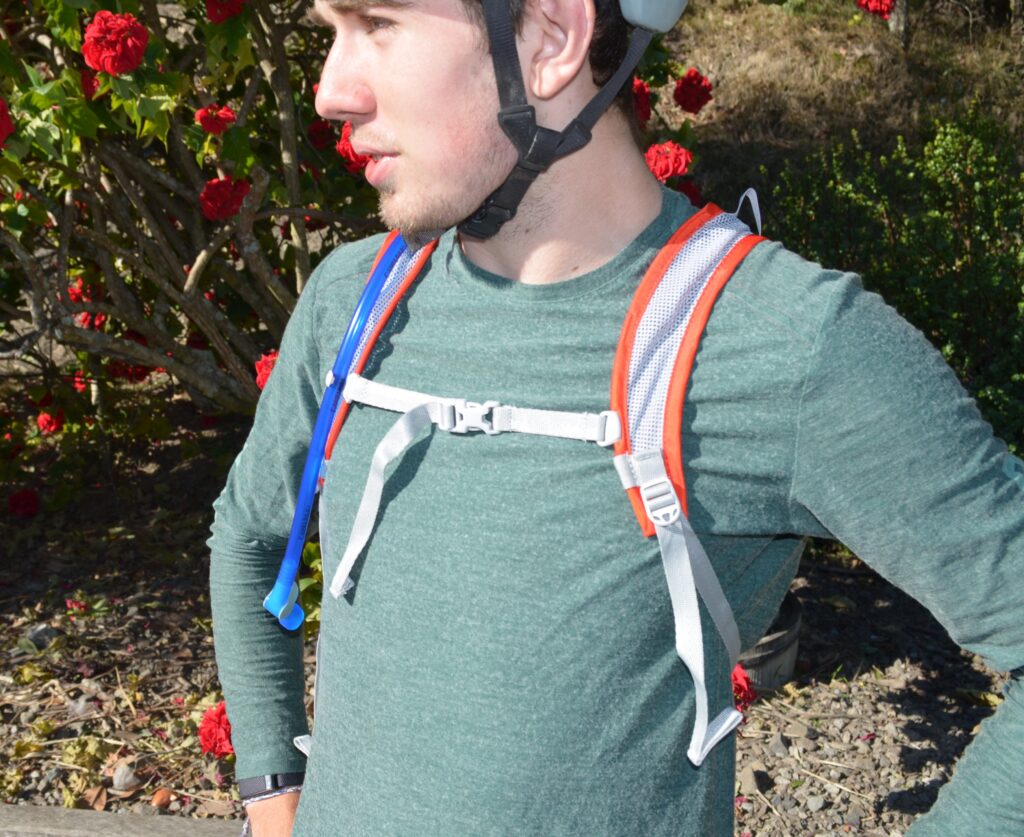
The only downfall of the Hydrobak in my opinion is the hose attachment, unlike some of the other packs we’ve tested, it features a pretty cumbersome attachment which makes it harder to drink on the fly.
Who’s it for? The Camelbak Hydrobak is perfect for riders needing a pack for rides around that 3 hour mark. You’ve got enough room for water, spares, food and that’s about it.
More info here
Ratings
Comfort 4
Aesthetics 3
Durability 4
Features 4
Overall 4
Camelbak LOBO hydration pack
RRP: $219.00
Weight: 685g
Storage volume: 7L
Hydration Capacity: 2L
The Camelbak LOBO hydration pack has been around for a long time: nearly 20 years ago when I had just jumped into mountain biking the LOBO was a prominent hydration pack option even then (‘alright grandma, let’s get you back to bed’ – my daughter).
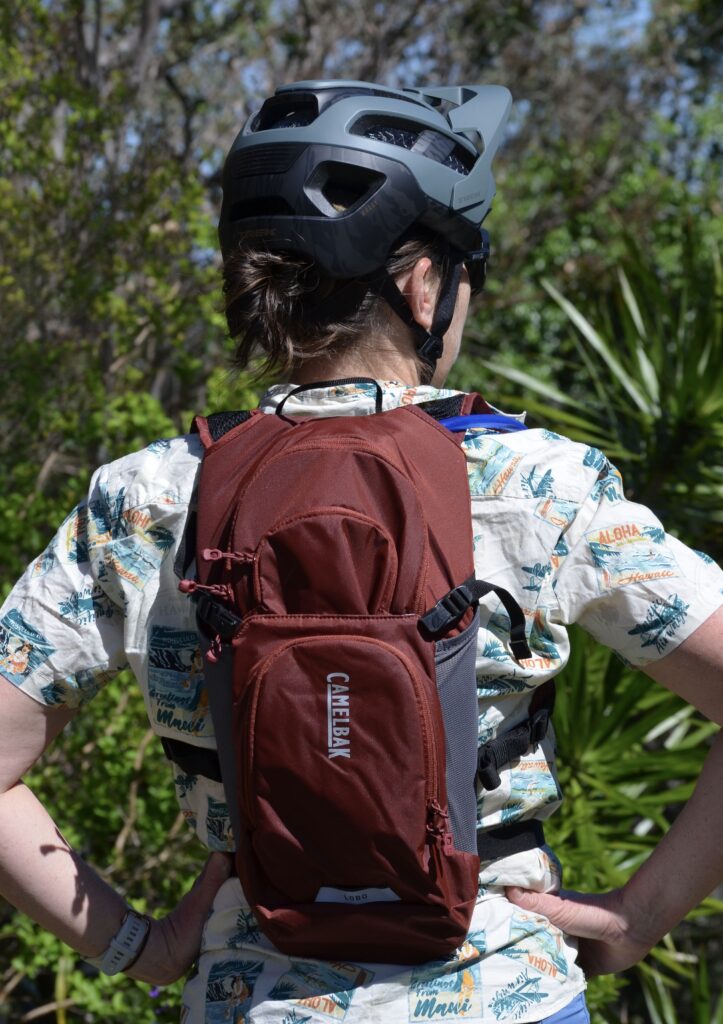
Back then, it sure didn’t feature a magnetic sternum strap attachment for the hose (something Osprey have been doing for a while), a helmet holder, or the Air Support system, which acts to suspend the pack somewhat off the back by three raised mesh-wrapped foam sections: on either side of the spine and a lower central triangle.
I also liked the use of the CRUX bladder throughout all the Camelbak bags, featuring a large circular inlet for water and a handle to hold it horizontal while it fills. The only issue we found with this is that it would take a fair bit of maneuvering to fully fill the bladder, but that is the trade off for not having to remove from the pack to fill up. It’s something to be mindful of when filling up, as it’s easy to think the bladder is full, but you’ve only filled 1.5L of the 3L bladder.
Fit and style-wise, it’s unsurprising that the LOBO is most similar to the Camelbak MULE. In fact, I would go as far as to describe it as the MULE’s slimline sister. With a total volume of 9L, It lacks the large central compartment of the mule, but retains the helmet straps, expandable front section with mesh pockets, and front tool pack and organiser. Also unsurprising was that the fit was very similar to the MULE, with the same magnetic hose holder and chest clip.
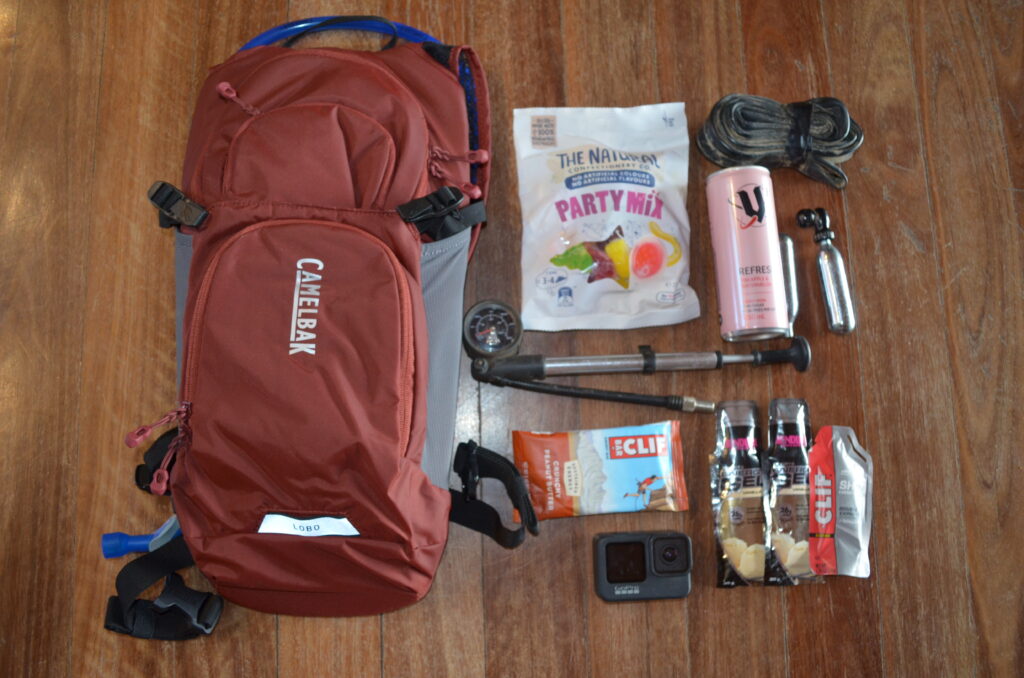
Described as a ‘quiver killer’ for packs, the LOBO ended up being a good intermediate option, for moderate length rides or carrying a bit more than the essentials. I enjoyed shoving a jacket in the expandable outer pocket, and the attention to detail with the tool storage. Despite having less volume than the MULE. I found that the LOBO’s pocket arrangement, in particular the outer zip pocket, made it a little easier to navigate and a little more functional than the MULE.
I loved the use of Bluesign approved fabrics across the Camelbak range, I just wish that they put a little more thought into the waist straps on the LOBO. A basic waist strap is ok for a smaller pack, but a fully loaded pack deserves a more comfortable mesh option in my opinion. While the waist straps are removable, if you’re doing any technical trail riding you’ll need them in situ.
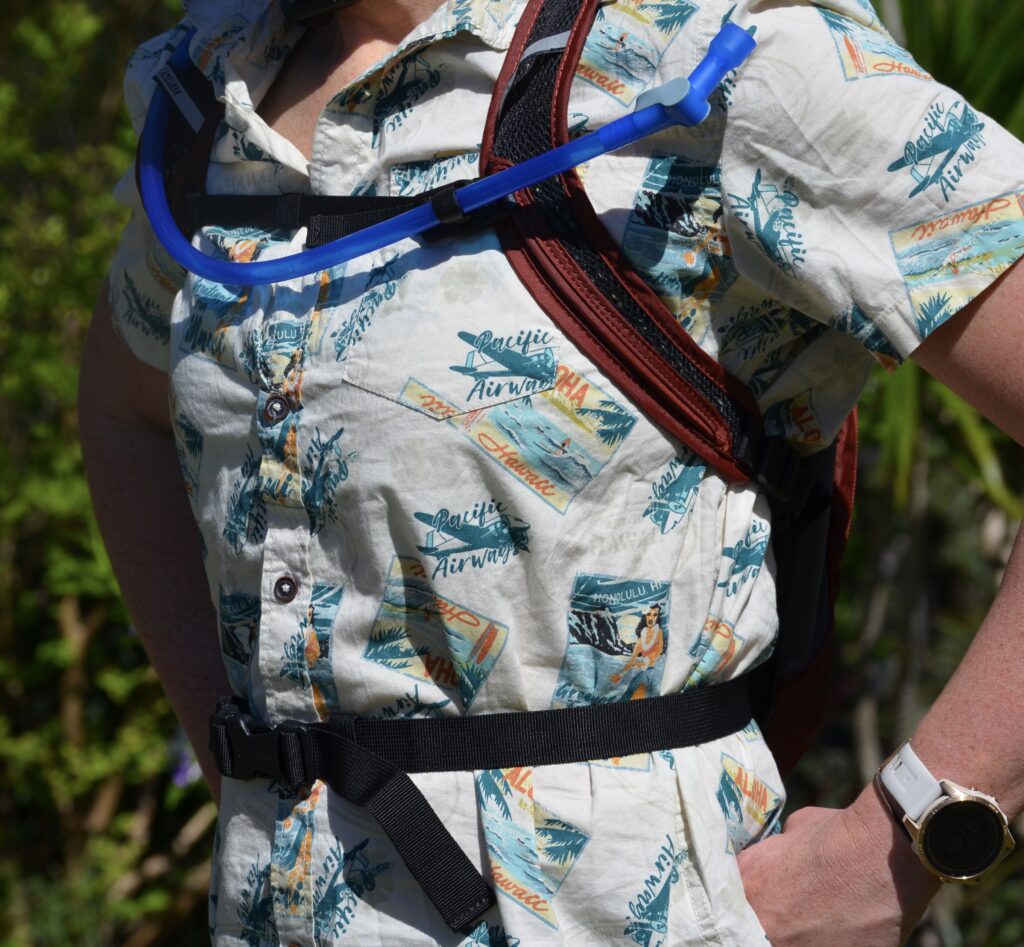
Who’s it for? A good intermediate option between race packs and big all day numbers, the LOBO retains some of the quick access features like mesh pockets of the smaller models, while incorporating a little extra storage, good for the everyday trail rider that requires a bit more than the essentials.
Ratings
Comfort 2
Aesthetics 3
Durability 4
Features 3
Overall 3
Camelbak MULE 12 (women’s tested)
RRP: $279.99
Weight: 752g
Storage volume: 9L
Hydration Capacity: 3L
The Camelbak MULE hydration pack is another model, like the LOBO, that has been around since the dawn of time (or so it seems!). With 9L of storage volume and a 3L bladder capacity, this pack was one of the largest volume on test.
Featuring the same magnetic strap holder as the LOBO, the MULE is your all-day pack that has a multitude of features including: hip belt with storage pockets, helmet carry buckles, an integrated tool-roll, 3D mesh ventilated harness, stretch overflow pockets (for stashing vests etc) and accessible integrated waist pockets for snacks on the go. Camelbak states that their women’s specific range features a more contoured ‘S-shaped’ harness, as well as smaller torso length to suit smaller riders. All this tech pushed the pack out to 720g, one of the weightiest on test, but also one of the largest in volume.
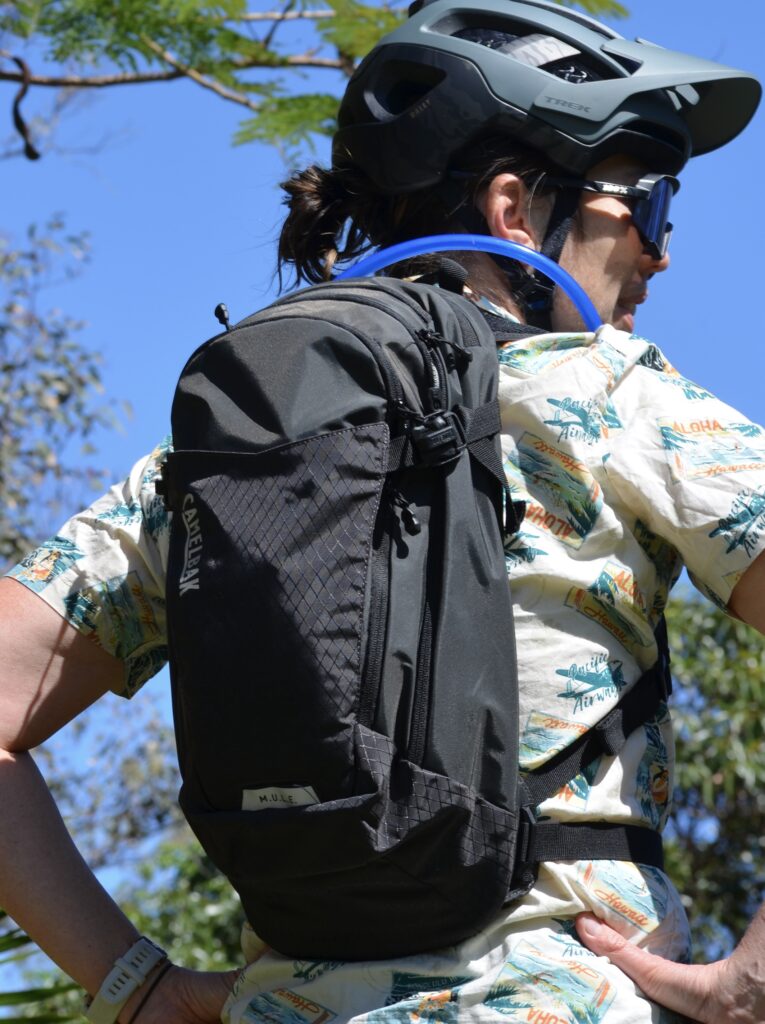
Those who love e-bike epic take note; Camelbak make a 14L offering of the MULE (MULE PRO) that also features e-bike battery storage and capacity for a rigid back protector.
We loved the tech on this pack; especially the versatility to strap your helmet for long uplifts, and the integrated tool roll and external stash pocket. We even loved the pockets for snacks on the waist straps. But while we loved all these features, we didn’t find ourselves gelling with the MULE as well as others on offer. One reason is because we found the upper zippers stacked against each other: medium pocket, small pocket, larger pocket. This stack of zips diluted the available storage and made it at times finicky to access specific things, as the stacked zippers meant that the pockets were deep and narrow.
Getting some opinions from other bag aficionados and they felt the same: the storage, while all together equalled a fair amount, was not the best use of space. We ended up using the exterior stash pocket more than anything else, mainly because I am impatient and zips take a while.
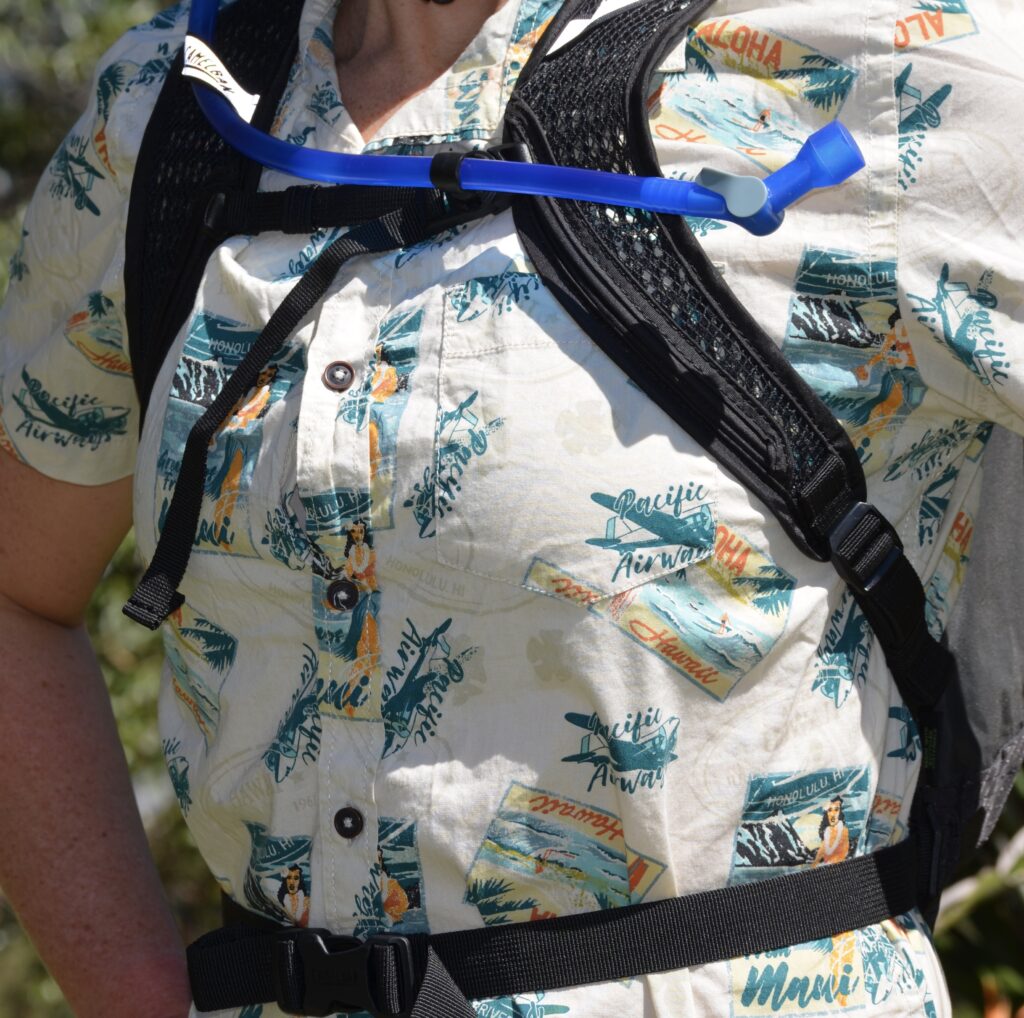
I also found that the fit wasn’t as comfortable as, for example, the Camelbak Chase vest or Deuter Superbike 8 (the aircomfort system hugs your back), Albek (cross body strap is supreme!) or the Osprey Kitsuma. I felt much more that I was riding wearing a pack, rather than the pack being an extension of myself on a bike. The magnetic hose strap was useful, but not as secure as the Osprey iteration of the same feature.
We liked the use of the CRUX bladder throughout all the Camelbak bags, featuring a large circular inlet for water and a handle to hold it horizontal while it fills. The only issue we found with this is in the larger packs tested is that it would take a fair bit of maneuvering to fully fill the bladder, but that is the trade off for not having to remove from the pack to fill up. It’s something to be mindful of when filling up, as it’s easy to think the bladder is full, but you’ve only filled 1.5L of the 3L bladder.
Who’s it for? Need to carry some stuff for a big day out and don’t mind zips? The MULE 12 may be your best option!
More info here
Ratings
Comfort 2
Aesthetics 3
Durability 3.5
Features 4
Overall 3
Dakine Shuttle 6 Women’s
RRP: $160.00
Weight: 447g
Storage volume: 4L
Hydration Capacity: 2L
The Dakine Shuttle 6 hydration pack was a latecomer to the hydration pack group test, but we were super excited to include a brand that is happy to explore outside the boxes of grey and black for hydration backpacks. The Shuttle 6 women’s was easily the best looking pack on test, with it pink-teal marbled pattern standing out in the crowd.
I was also pleasantly surprised that despite the pack being less targeted towards the ‘racing’ crowd, it was one of the lightest-weight options on the test at 447g with bladder.
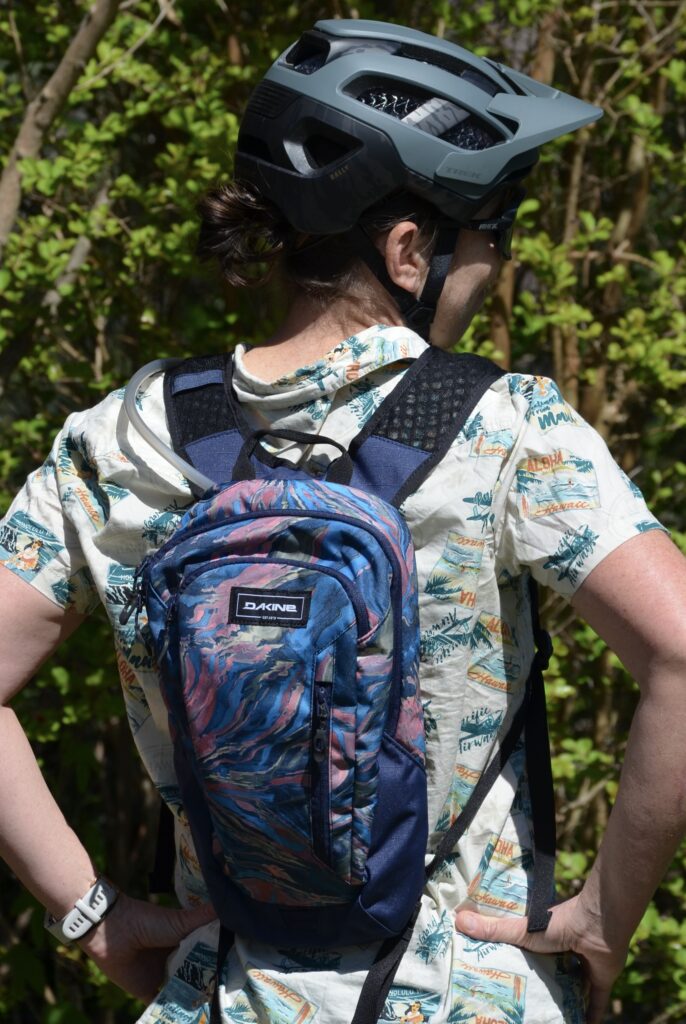
With perhaps less technical features than some of the other options on test, the Shuttle 6 does feature some mesh on the shoulder straps for heat transfer, and some mesh webbing on the main contact patch of your back. Without a suspended back it was one of the warmer options on test, however this was somewhat mitigated by its smaller depth. While it wasn’t as short as the Albek or the Camelbak Chase, it was significantly shorter than the Osprey Kitsuma (with a similar volume) and the Deuter Race 8, meaning that more of your back can keep cool when wearing the Shuttle.
We also appreciated the presence of a chest and waist strap feature on a smaller pack, something other brands had missed with lower volume packs.
In terms of storage the Shuttle keeps it easy: a vertical pocket on the exterior perfect for some snacks or spares, and a fabric lined top pocket which works well for keeping your phone secure. There is a small amount of extra real estate in the bladder compartment that would work well for a cheeky wind jacket stash on the go.

The Hydrapak bladder itself is a super simple affair, with a sliding mechanism to refill and a bite valve to drink. We had no problems with these in the short term, but having used this type of bladder before I know that keeping it clean and mould-free can be a bit of a pain.
I enjoyed the simplicity of this pack, and the fact that it just worked and didn’t overcomplicate things.
Who’s it for? I recommend this for someone who is riding for shorter or moderate periods of time, but doesn’t need speedy ‘on the go’ snack access. For a lightweight hydration pack on the minimalist end of the spectrum that packs a punch of colour, you can’t go past the Dakine Shuttle 6.
More info here
Ratings
Comfort 3
Aesthetics 5
Durability 5
Features 3
Overall 4
Dakine Drafter 10 Women’s
RRP: $200.00
Weight: 680g
Storage volume: 7L
Hydration Capacity: 3L
The Dakine Drafter 10 hydration pack was supplied in both women’s and men’s sizes for the group test. I tested the women’s option: this measures up a little shorter than the men’s and also features narrower shoulder straps. We enjoyed Dakine’s departure from ‘safe’ block black packs with the squiggly grey and black design: it’s casually understated.
A bit of an overhaul in terms of design, the Dakine Drafter 10 is the only option on test that features bladder access from the bottom of the pack, with the top zip to the compartment revealing e-bike battery storage, deep pockets and access from the underside of the suspended back as an option to run the pack in the standard configuration.
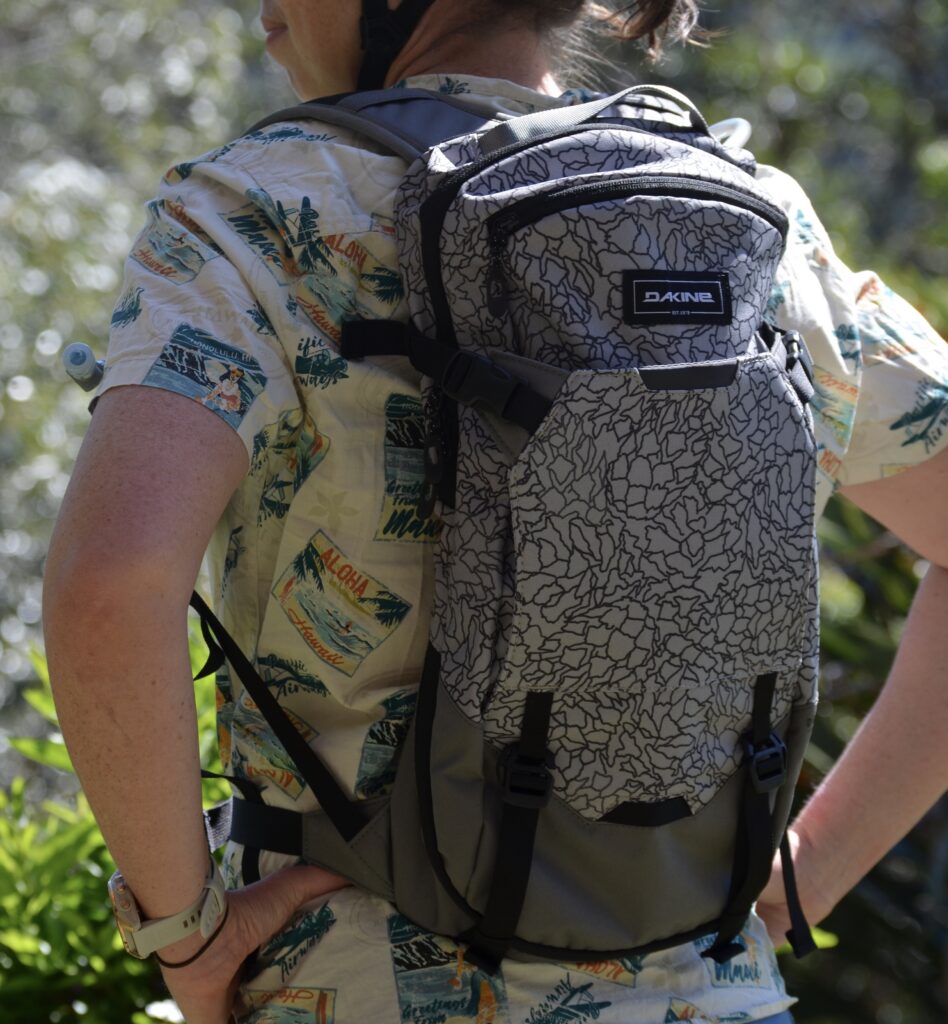
In addition to this, the Drafter also features the fabric-lined phone or glasses pocket, an expandable stash compartment on the front with another key and snack storage compartment nestled inside the stash area.
For some extra portaging, the Drafter 10 also features a set of deployable easy-access external carry straps, a prime spot to throw knee or elbow pads into.
With 7L of very usable storage, this pack is better equipped for all day adventures, and primed for backcountry epic adventures or big days on the chairlift or shuttles at the bike park. It’s also the only option on the test that featured dedicated e-bike battery storage, which will surely be a feature in more packs in the future.
Compared to its little sister the Shuttle 6, the Drafter features increased hydration capacity with a 3L Hydrapak bladder. It has the same slide mechanism to open and close to refill, but this model features an open/close switch on the mouthpiece, as well as a magnet that links up to the sternum strap.
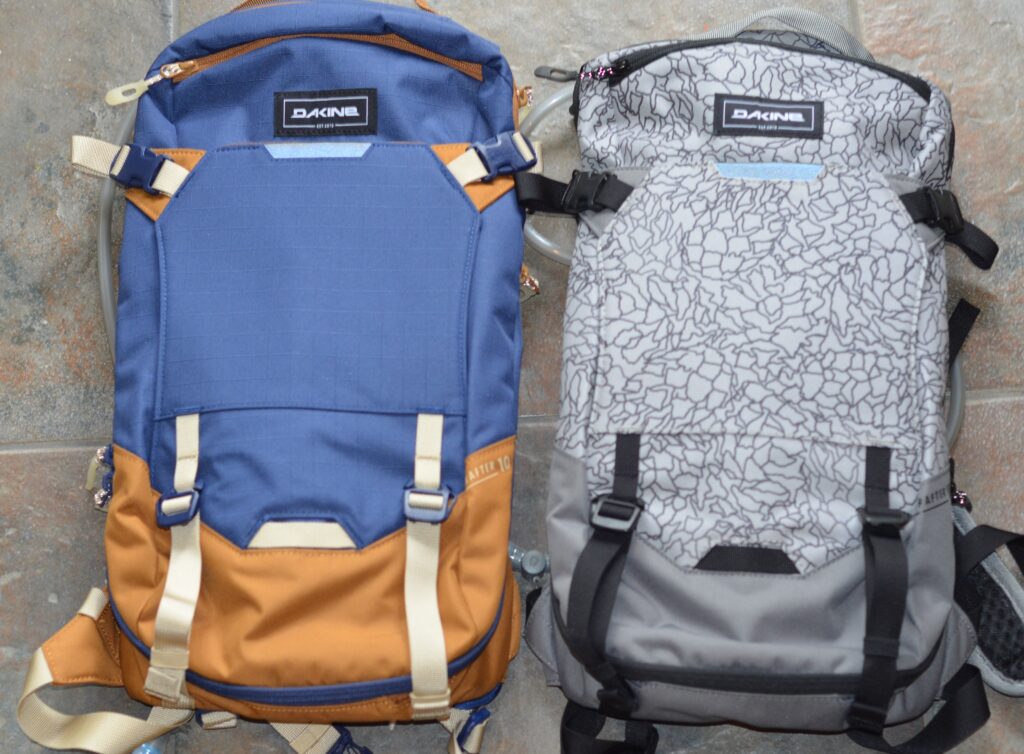
The Drafter was a very comfortable pack and I could see it being useful on huge e-bike days, or really long adventures that feature transfers. There was more than enough room for snacks and for warmer weather the AirLite suspended back panel really helped increase airflow which was much appreciated with the footprint of this larger pack.
Who’s it for? The drafter is very much an all-day pack, with features suited to the bike-park lover and e-bike enthusiast.
Comfort 4
Aesthetics 5
Durability 5
Features 4
Overall 4.5
Deuter Race 8
RRP: $139.00
Weight: 446g (no bladder)
Storage volume: 8L
Hydration Capacity: Your choice
Deuter is a German bag manufacturer that has packs for activities ranging from hiking to carrying children and cycling. Of all the packs we have tested, the Race 8 hydration pack flew under the radar more than most. An unassuming exterior appeared to be quite bland and lacking features until we unpacked it and looked a bit harder.
Rated as a great gravel and mountain biking option, the Race 8 is our only option on test that comes without a bladder and while some may consider this a drawback, it allows a little more flexibility in terms of choice of hydration capacity. For those looking at a lightweight option to support your existing bottles on bike, you could consider a 1L while using this as a flash-pack option or for a big day backcountry you could look for a 3L bladder.
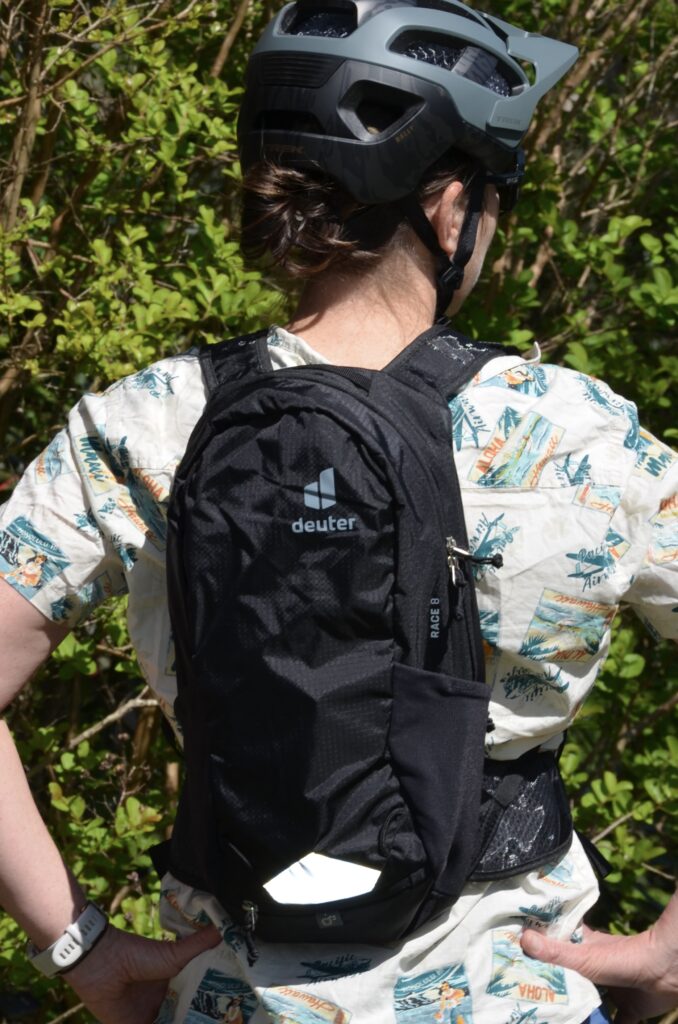
As someone who enjoys a commute, a flashback, and a big day on the trails this is actually a pretty interesting bag. It does feature mesh side pockets for snack access and a deep main compartment for your mid-ride burrito. The capacity is pretty immense and features a zipper pocket and key holder, making it a good option for those who do a lot of outdoor activities and want to carry a jacket and an aero press, for example.
Another feature that lends itself to versatility is the integrated rain cover, which is likely the reason it is one of the weightier options on test. Snuggled into a small pocket at the bottom of the bag, the rain cover is a feature I have used many times on a very elderly 10+ year old Deuter commuter bag (testament to the brands durability!), offering a rain cover for your bag and also added visibility from it’s immense yellowness and reflective graphics.
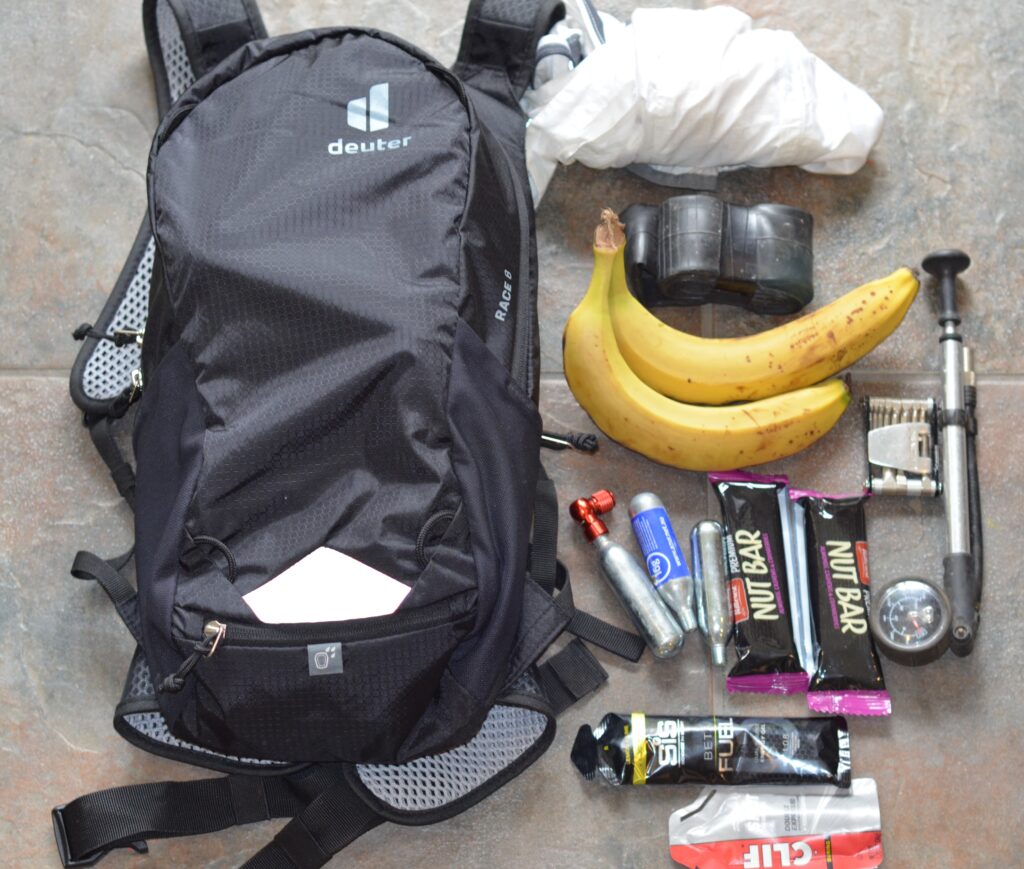
The race 8 also features both a chest and waist strap, and is held snug against the body with their Airstripes system: two strips of raised, meshed padding that contours to your back but keeps the contact patch of the bag much smaller than if the entire rear of the bag was sitting on your back.
Who’s it for? The Deuter Race 8 if for the minimalist flash packer, outdoor enthusiast that enjoys a range of activities that need a deep compartment for stuff, a commuter turtle, or a rider that likes to get dirty on trails but also needs a pack with good heat transfer in warm conditions, and good features for wet rides.
Ratings
Comfort 5
Aesthetics 3
Durability 5
Features 4
Overall 4
Osprey Kitsuma 7
RRP: $169.95
Weight: 503g
Storage volume: 4.5L
Hydration Capacity: 2.5L
The updated Osprey Kitsuma hydration pack is designed for those who want to carry a little more than water, but don’t need the full capability of a day pack. With a 7L total volume, the Kitsuma 7 features the largest capacity of the Kitsuma range; which also features 1.5L and 3L volume options for super lightweight hydration options for racing snakes and minimalist types.
While the Kitsuma 7 is a women’s specific pack, Osprey also produce the Katari in a parallel range that mirror the features of the Kitsuma range. What’s different? Well Osprey state that the women’s fit features an shorter back length, narrower shoulder width, and a female-specific hip belt from the men’s version. If you’re a very tall woman it may be best to test out both options to see what fits you the best.
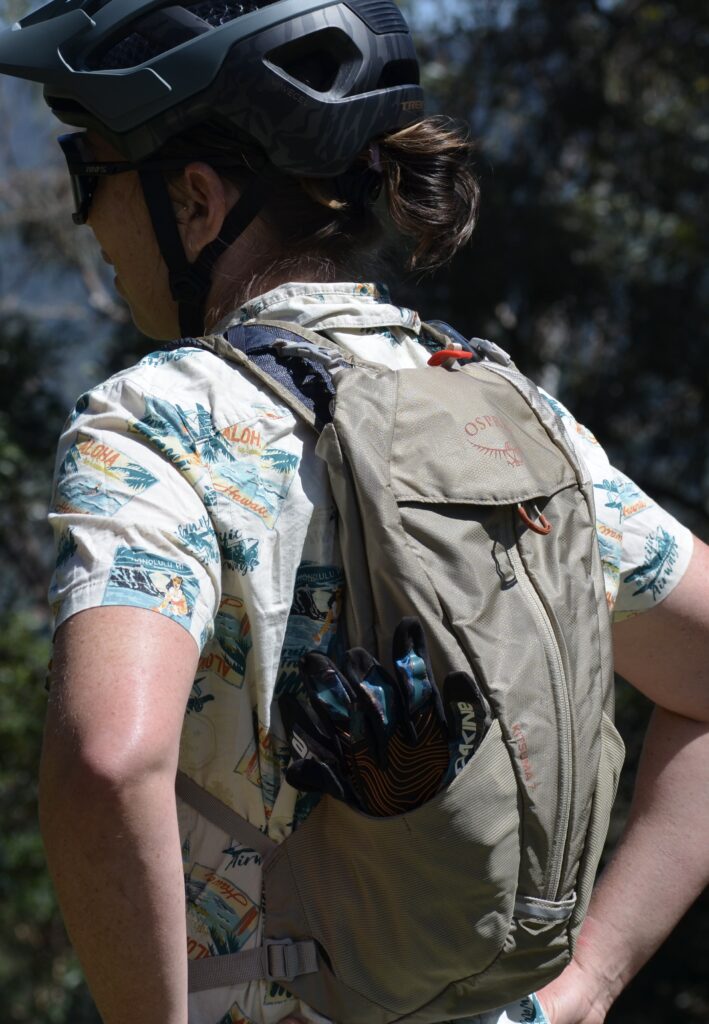
Osprey are committed to using Bluesign approved fabrics, sourcing recycled materials and PFAS-free water repellants
Featuring a Hydraulics LT 2.5L hydration reservoir, the Kitsuma has a high capacity for all-day adventures, with one of the most unique features being a front panel vertical zip compartment. Inside the zip there are two pockets for tool organisation as well as extra volume for snacks/clothing. For even more snack access on the go there are two mesh pockets on the exterior.
In terms of fit, Osprey has used their patented Airscape suspension back that claims to evenly distribute weight across the back, alongside a biostretch harness with soft edges around the underarm-facing fabric on the shoulder straps in order to reduce the risk of chafe, and ridged mesh to optimise cooling on hotter days. While the Kitsuma 7 sports a webbing hip belt, the lower-volume Kitsuma (and Katari) don’t feature a hip belt, which is something to consider if you prefer the extra stability this offers.
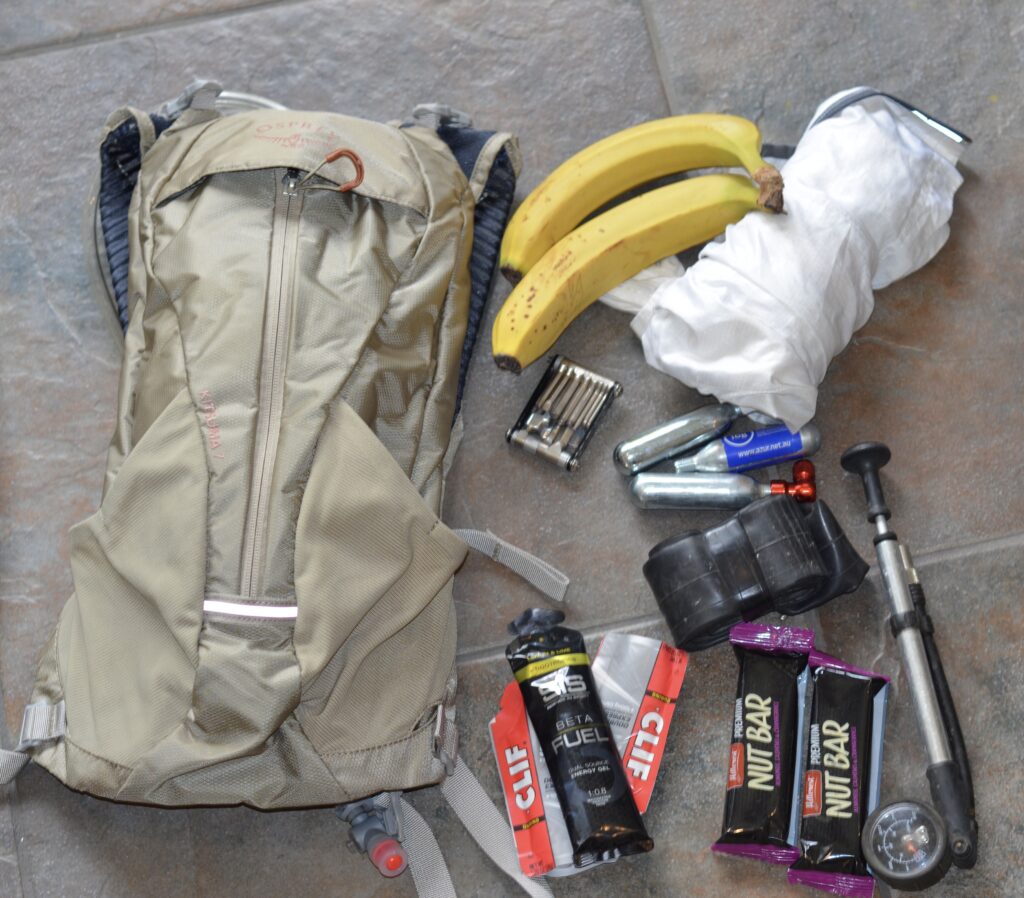
Accessing the hydration bladder is easy with an external reservoir sleeve, and a key feature of all Osprey bike packs is the magnetic sternum strap bite valve attachment.
But how did it ride? I found the back to be on the long side – though a tad shorter than the Camelbak Lobo and MULE (women’s) – so one to consider for taller riders. The magnet on the hose that connected to the chest strap was a great feature meaning it was easy to hold the hose in place and stop it flopping around between sips. We found the pack extremely comfortable on the shoulders, and while mesh pockets took some getting used to for quick snack acquisition, they were sturdy and secure and easy to grab a quick bar out of on the go once practiced.
We tested the Sawdust Tan colour, but the Kitsuma 7 is also available in Astrology Blue and Space Travel Grey.
Ratings
Comfort 5
Aesthetics 3
Durability 4
Features 5
Overall 4
Who’s it for? The Kitsuma 7 is for the all-day adventurer that likes to travel light and keep moving, with access to snacks on the go. With a hydration capacity of 2.5L, it’s suitable for 2-4hr rides depending on the climate.
Osprey Raptor 14 hydration pack
RRP: $269.95
Weight: 959g
Storage volume: 14L
Hydration Capacity: 2.5L
The Osprey Raptor 14 hydration pack is a 14L mountain bike hydration pack that is geared towards long days in the saddle, be that mountain biking, gravel riding or in my case bike packing. The 14L storage capacity combined with Osprey’s well designed pocket placements means that you’ve got enough room for anything you’d need from a 3 hour rip to a 10 hour slog. I recently just returned from a 5 day bike packing trip from Brisbane to Sydney, where the Raptor was sitting on my back day in day out. I was pleasantly surprised with how unobtrusive this pack was.
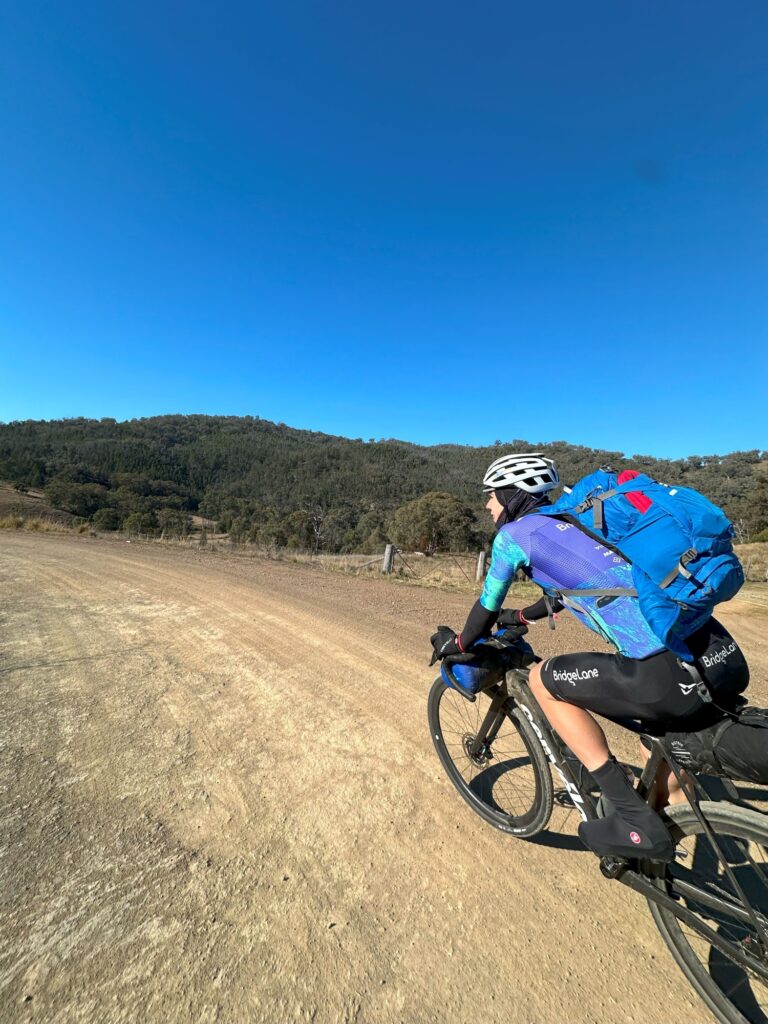
My trip consisted of 5 back-to-back 7 hour days covering anywhere from 130 – 170kms, it was fair to say we were moving pretty fast. Initially I was worried that carrying a pack for these distances would give my back a hard time. I was wrong, I could barely feel it. It was one of my main talking points each day about how I kept forgetting this pack was even there.
Let’s take a look at said pockets. The main compartment on the Raptor has more than enough room to carry all your essentials alone, with 3 smaller mesh pockets on inside to help keep organised. I found that most days I would shove my puffer, winter riding extras and speaker in this main compartment leaving plenty of room for food that I would pick up along the way.
The bottom of the bag features a really neat tool storage space with a rollout tool sleeve. This held my bike packing tool kit which features more than what most people would ever take out for a day ride.
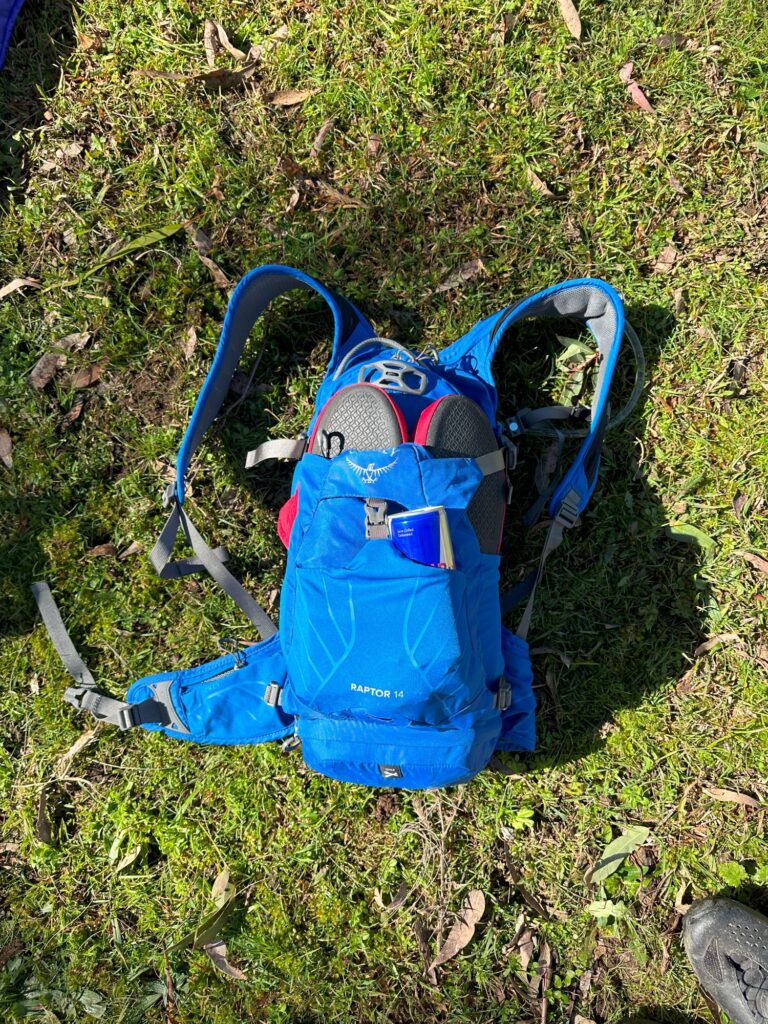
Other compartments include a smaller key pocket on the top, the main bladder compartment, 2 open compartments on the front, one being large enough to hold a rain jacket and a smaller ‘stretchy’ compartment right on the front and 2 spacious ‘stretchy’ hip belt pockets. The Raptor also features a helmet buckle which is useful if you are incorporating some hike-a-bike sections into your ride or just like to feel the wind in your hair #helmetsarecool
How did it ride? The fit was what made this bag stand out from the rest for me, it fit like a glove to my body. I weighed this bag in at around 6-7kg including the water in the bladder. Not once did I experience back pain or discomfort from having this bag on. In terms of water access, Osprey has incorporated a magnetic attachment system onto the sternum strap of the bag, making it really easy to access water on the fly.
Who’s it for? This isn’t a bag for someone who’s going out for a 3 hour MTB session on a Saturday morning, this bag is more suited to a ride that is heading out for an all day epic, or a ride that is going to remote locations that may need more than your normal riding essentials.
Ratings
Comfort: 5
Aesthetics: 4
Durability: 5
Features: 5
Overall 5
Winners
Anna:
My go-to for short, hard rides or to use for something swift like a mountain bike marathon would be the Camelbak Chase hydration pack. While I loved the Albek for its central locking mechanism and simplicity for the pure racer, the Camelbak Chase vest’s shoulder strap pockets really cinched it for me. I love snacks on the go!
For flash-packs, commuting or a more versatile option for a range of cycling, I would pick the Deuter Race 8. Wide waist straps and versatile interior space alongside the airstripe system and easy-to-reach snack pockets really ticked almost all the boxes for me, but it’s a ‘byob’ (bring your own bladder) affair.
Max:
I’m not the kind of person to ride with a hydration pack unless I have to, so for me the obvious choice was the Camelbak Chase Vest as it was small and I couldn’t feel it on my back. In saying that, the Osprey Raptor 14 hydration pack that I took on my bike packing trip from Sydney to Brisbane was very pleasant to ride with and had excellent storage capacity for that style of riding.

